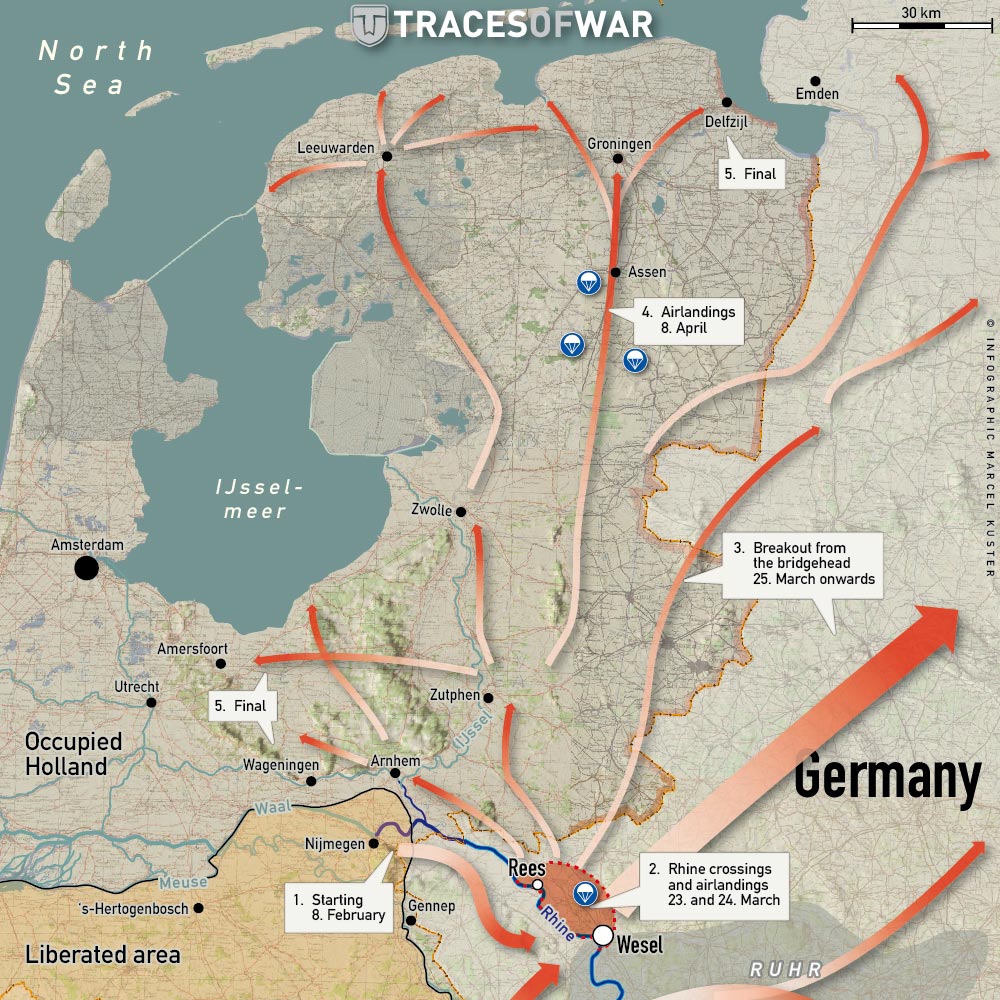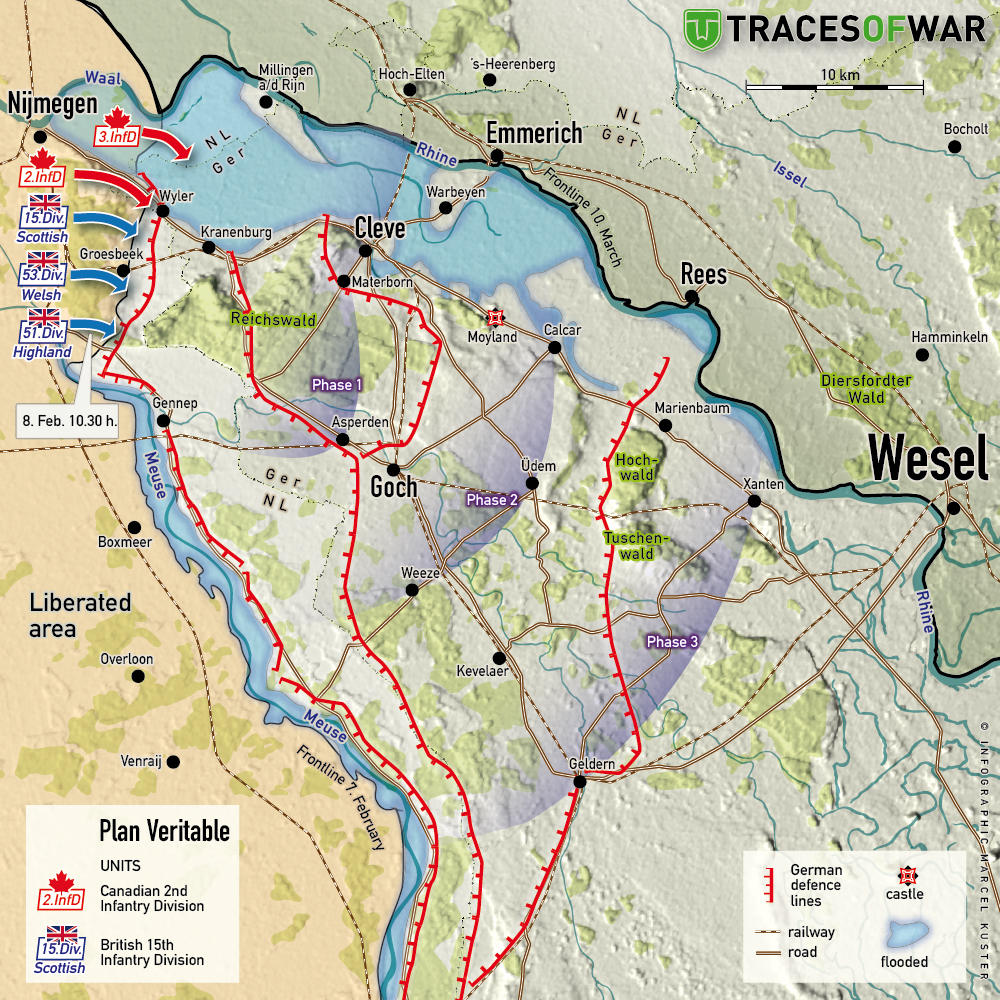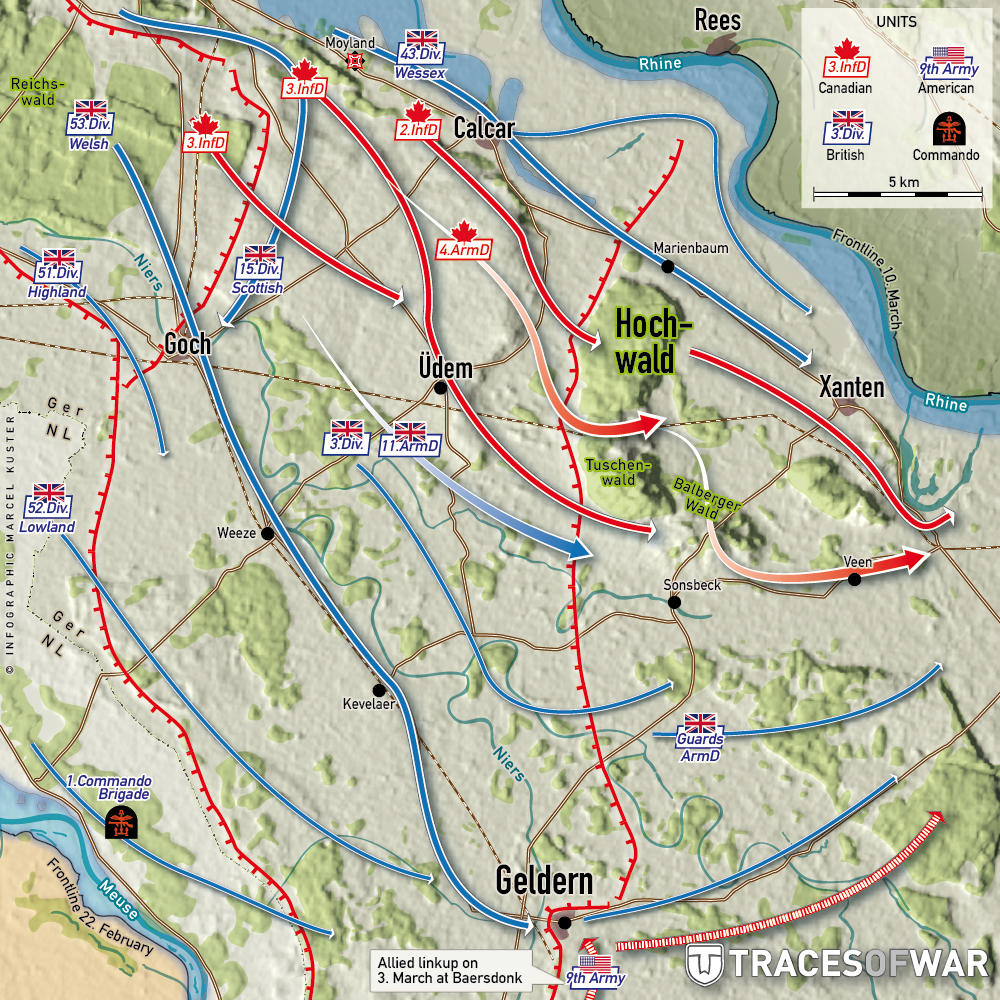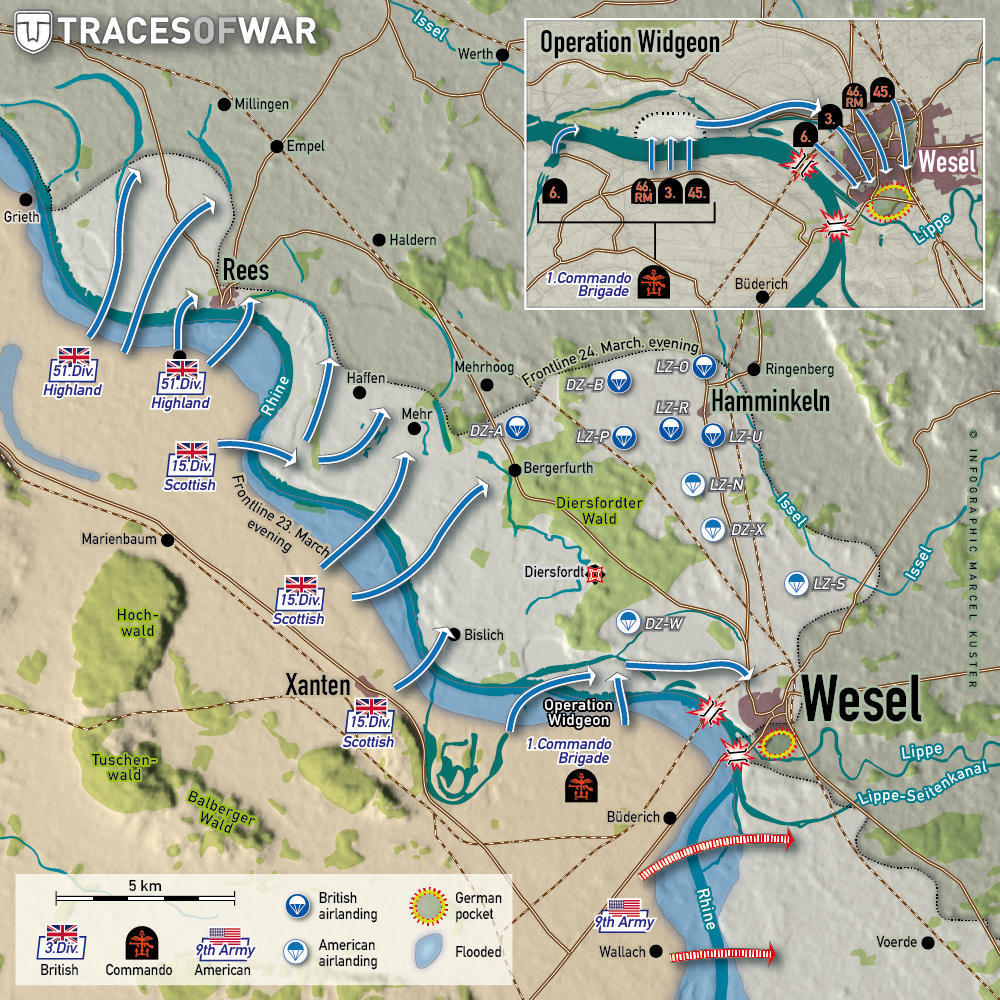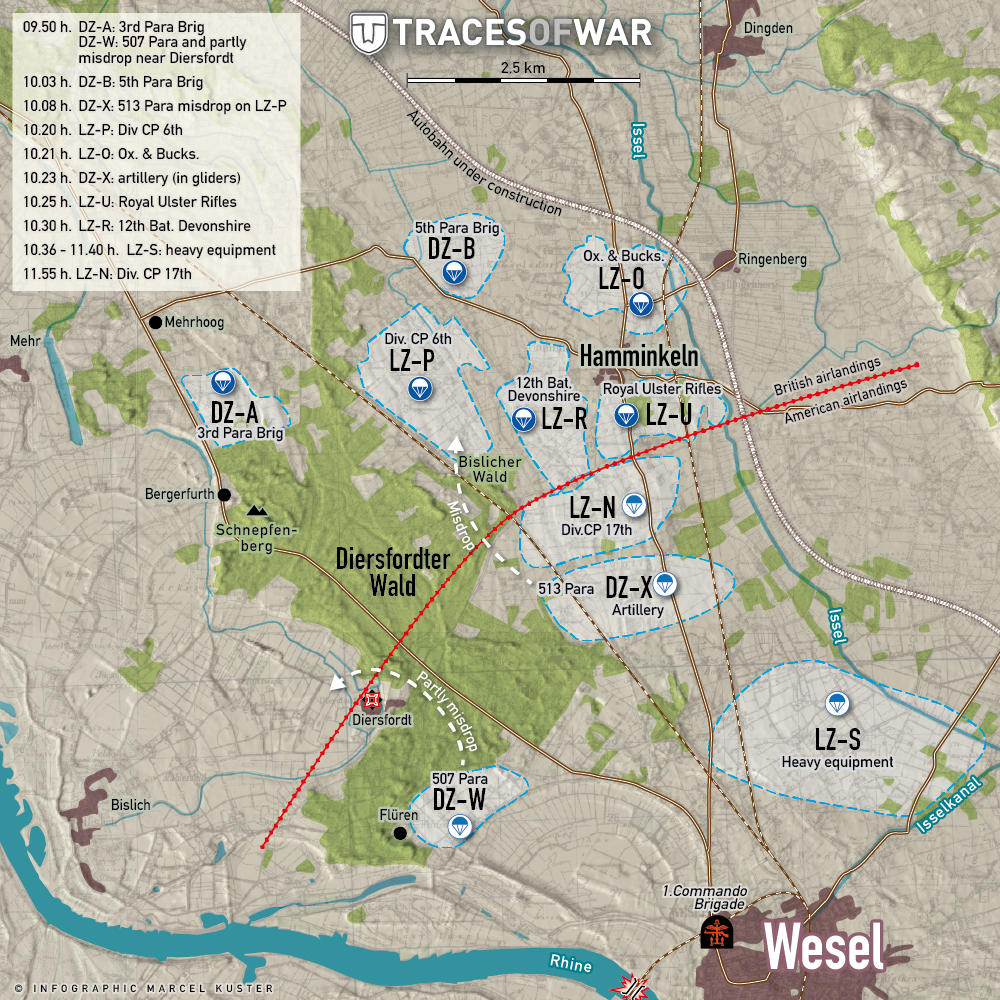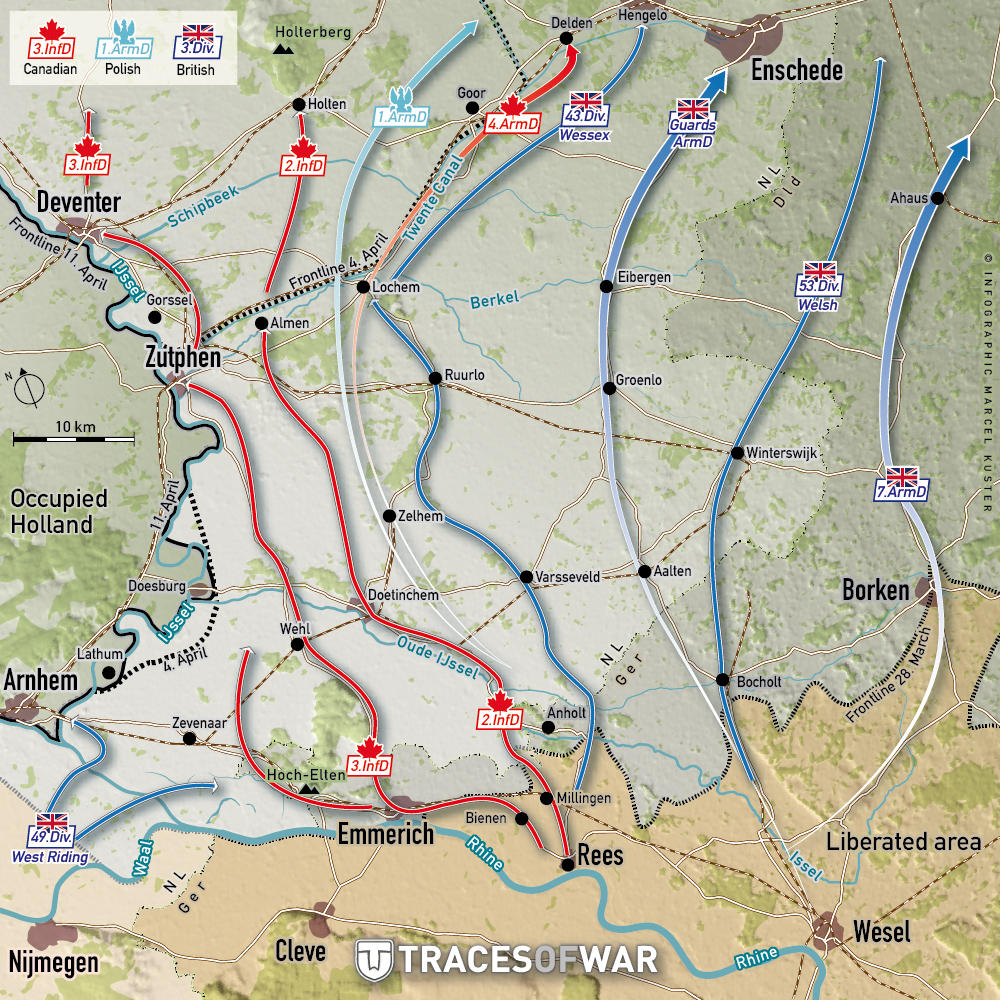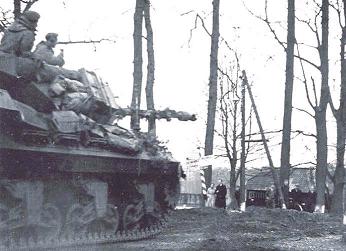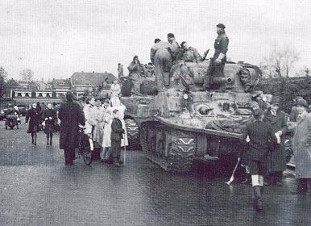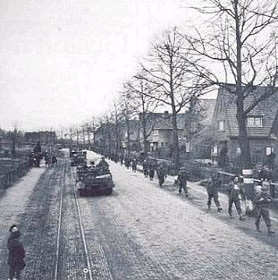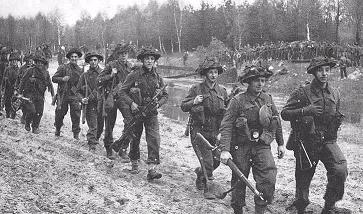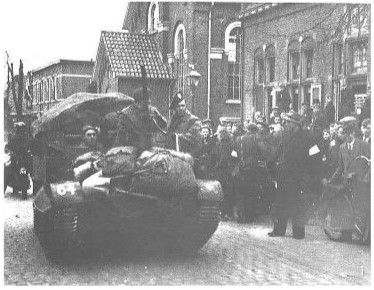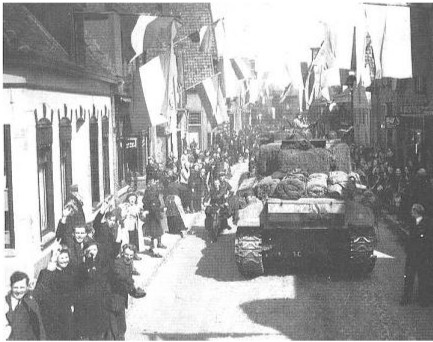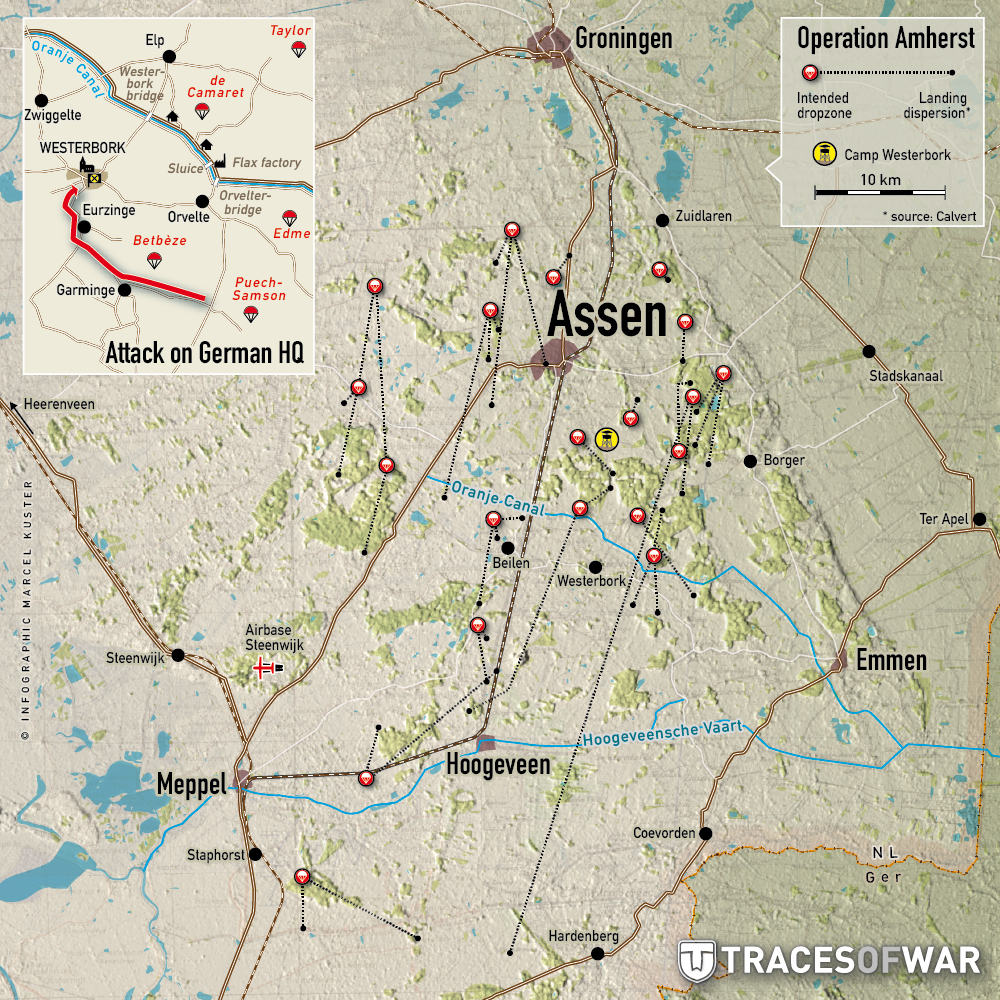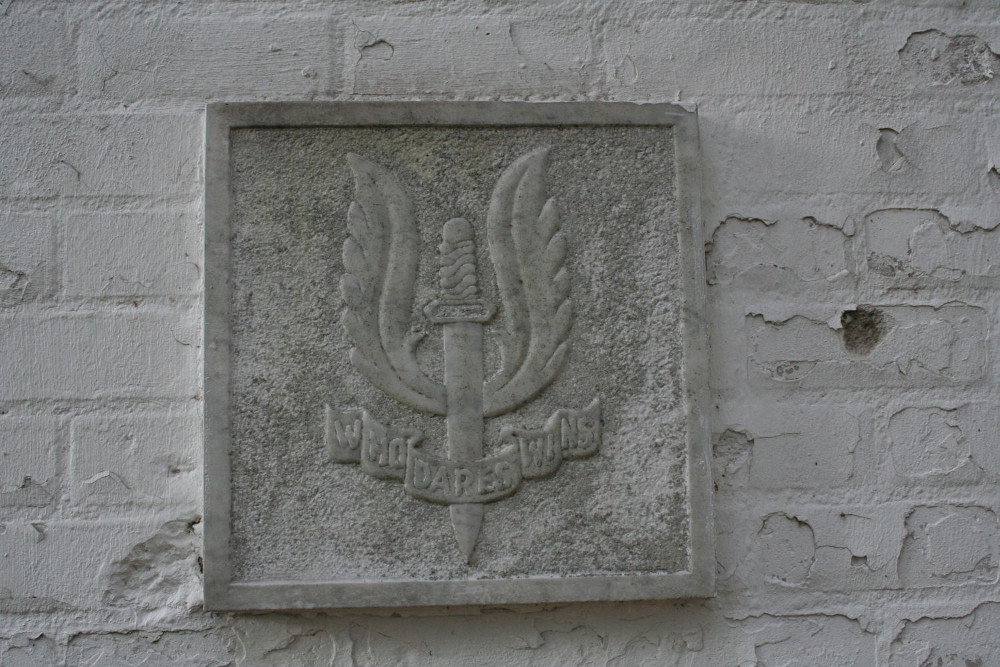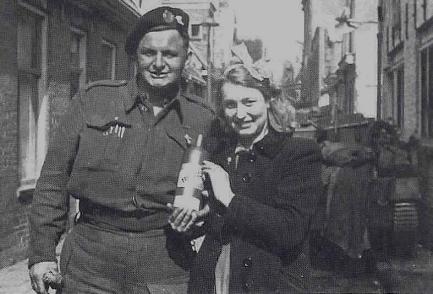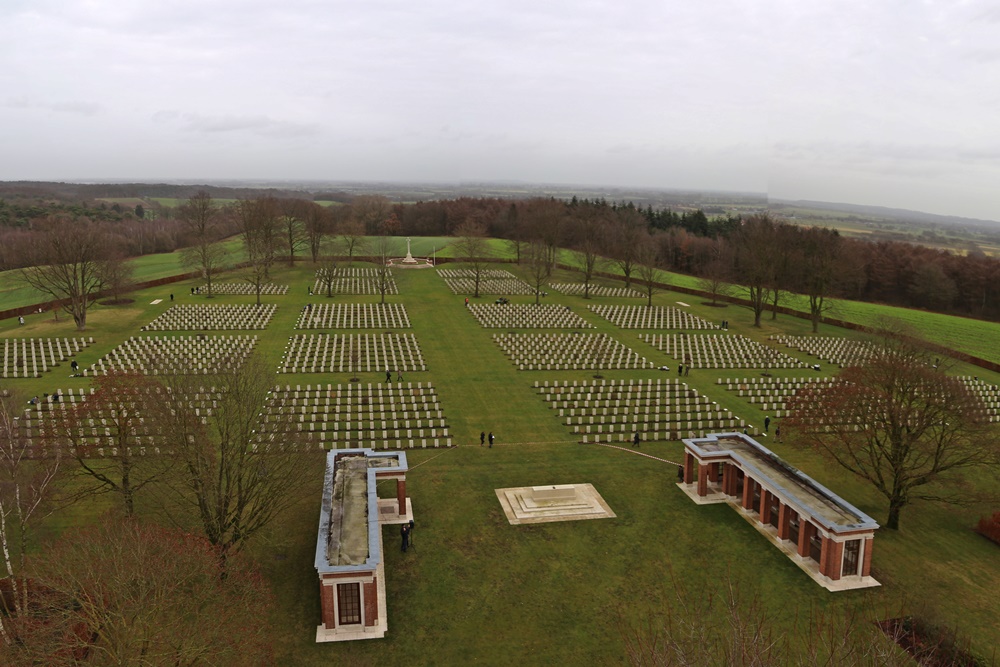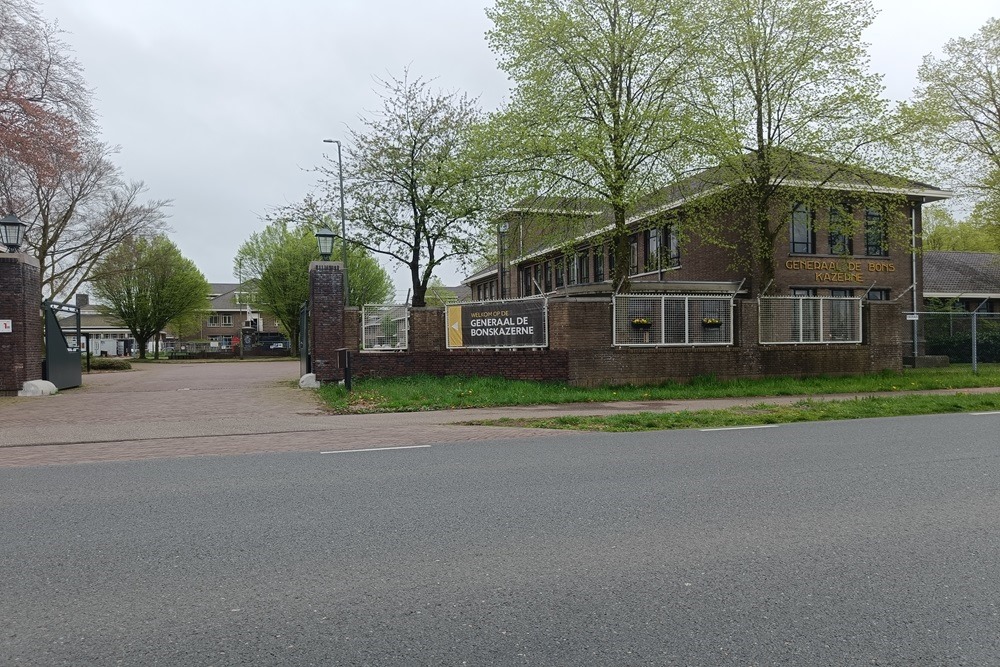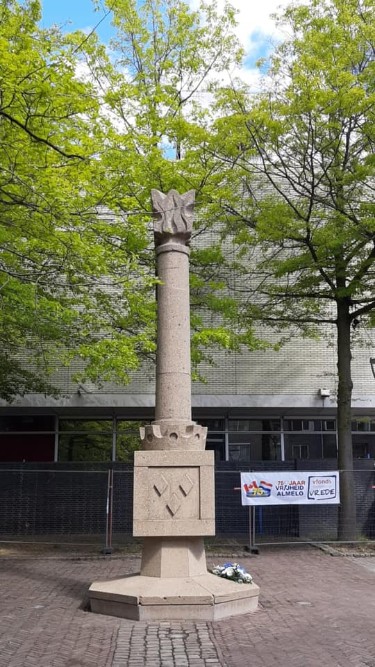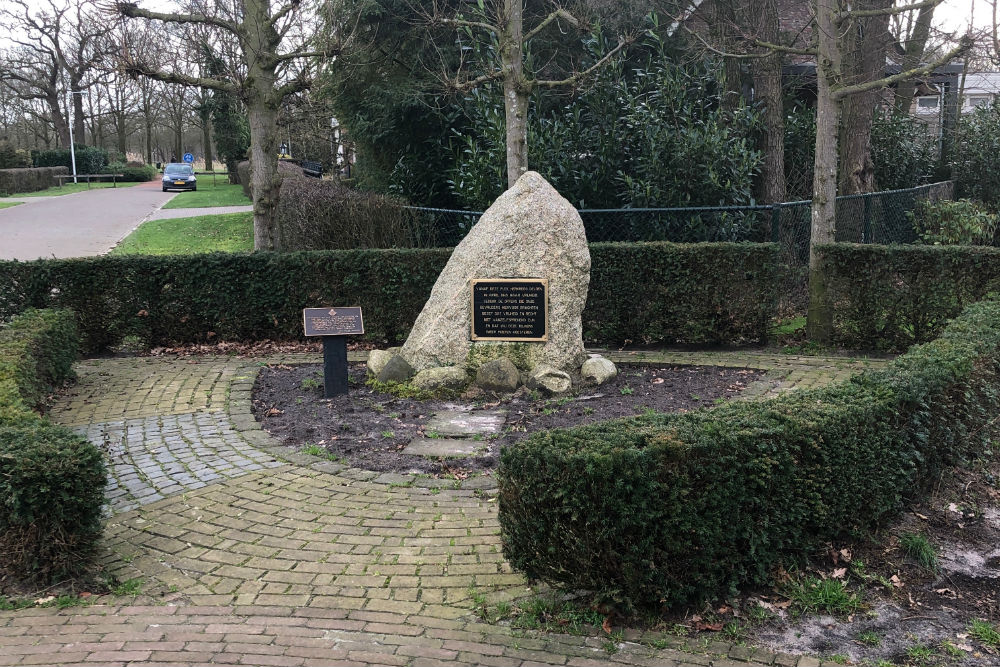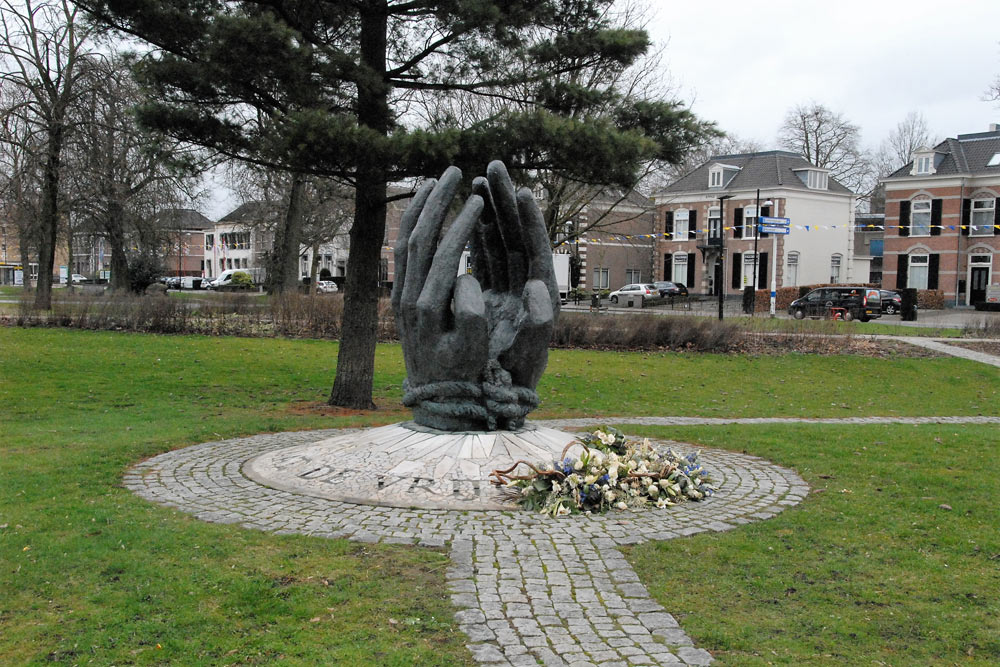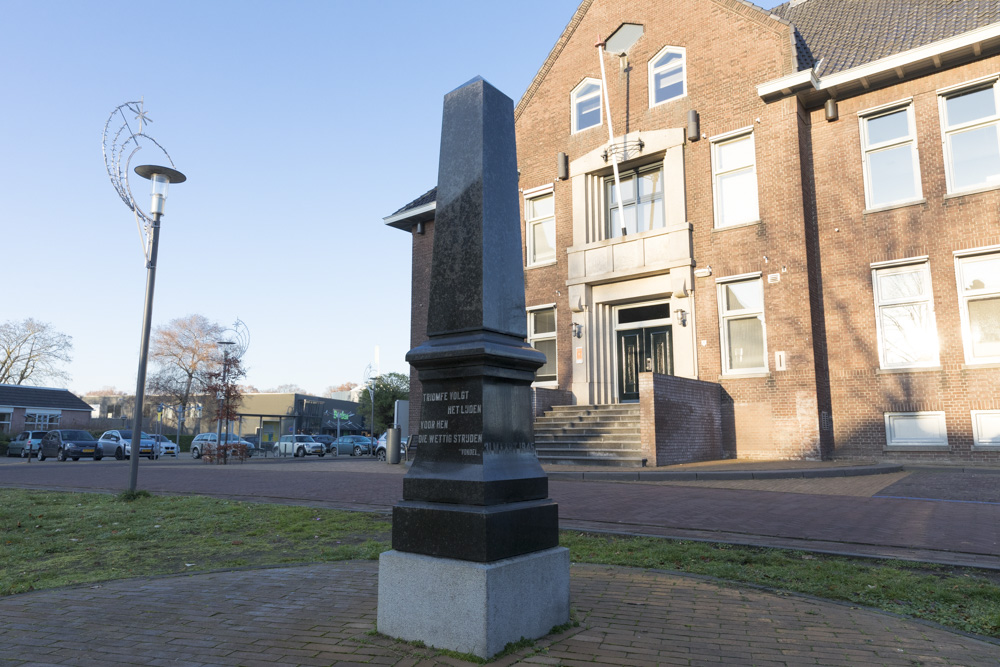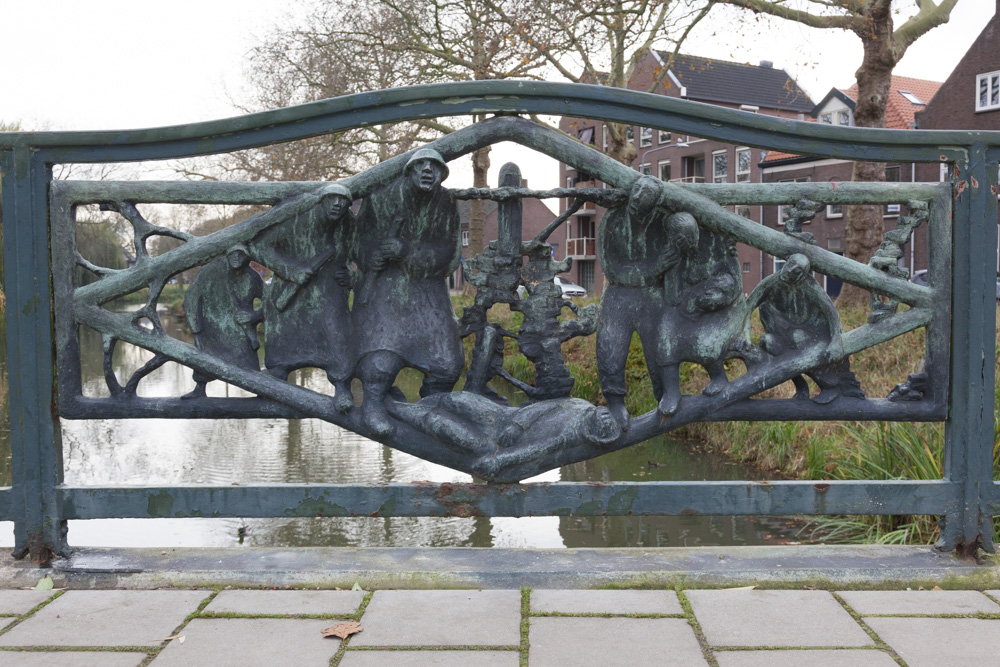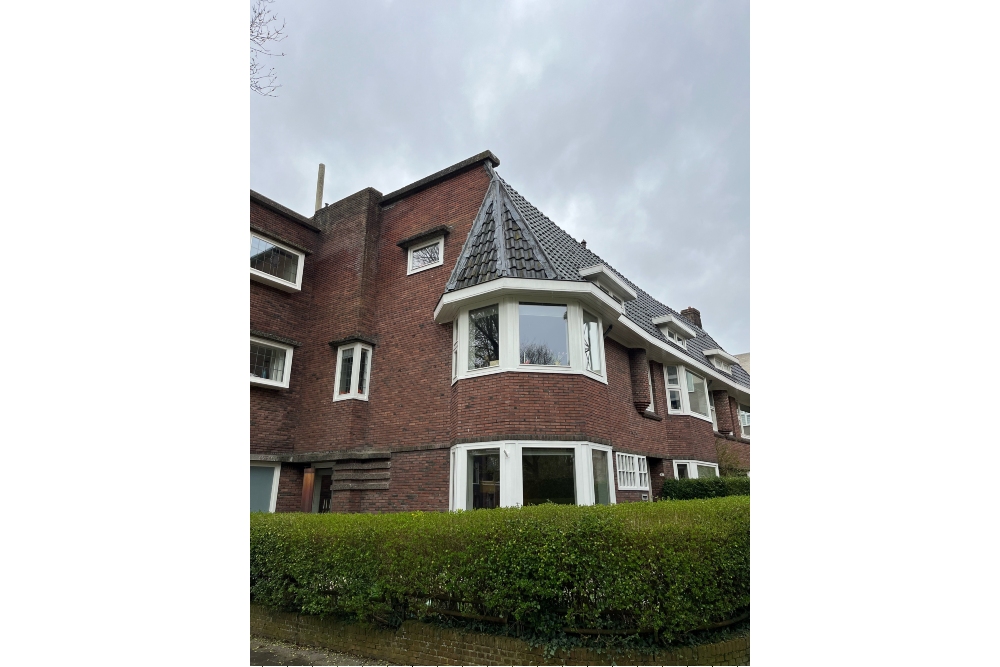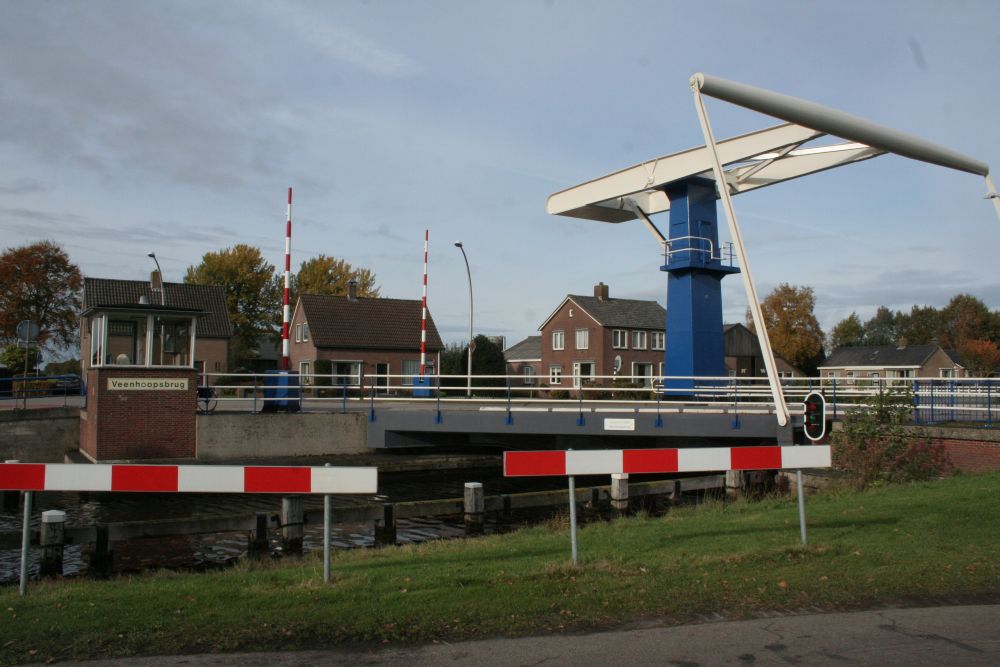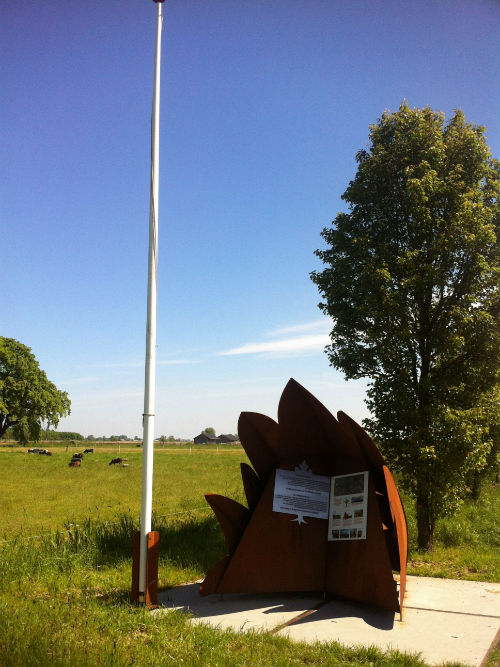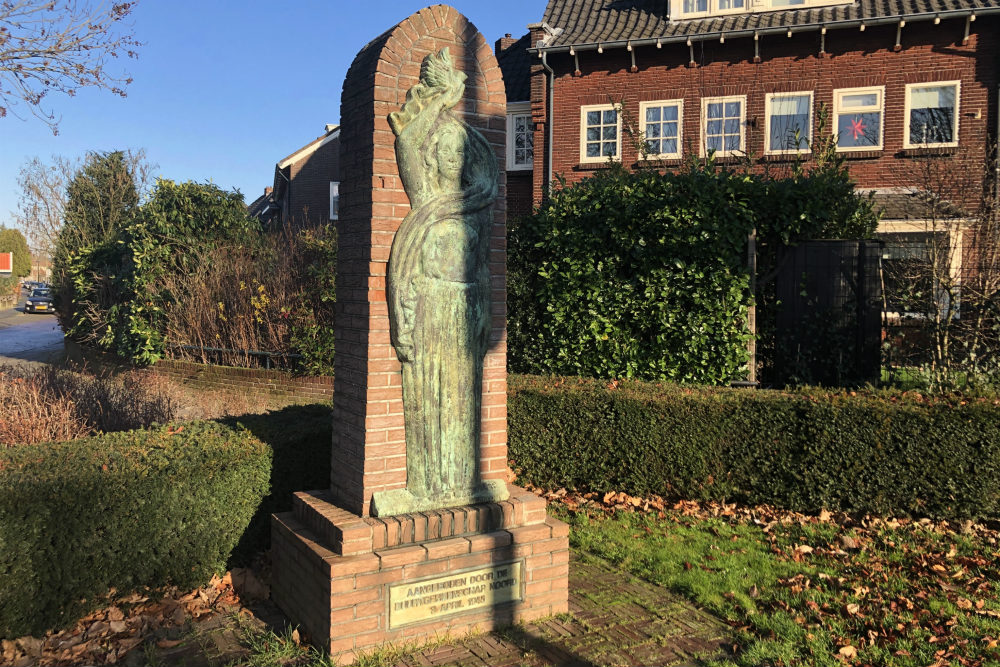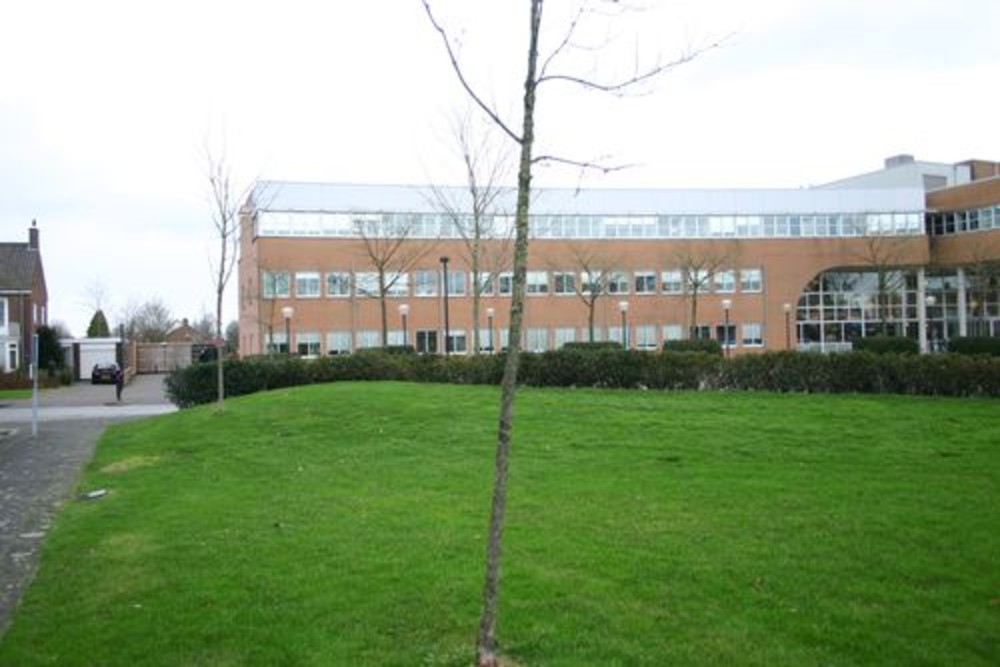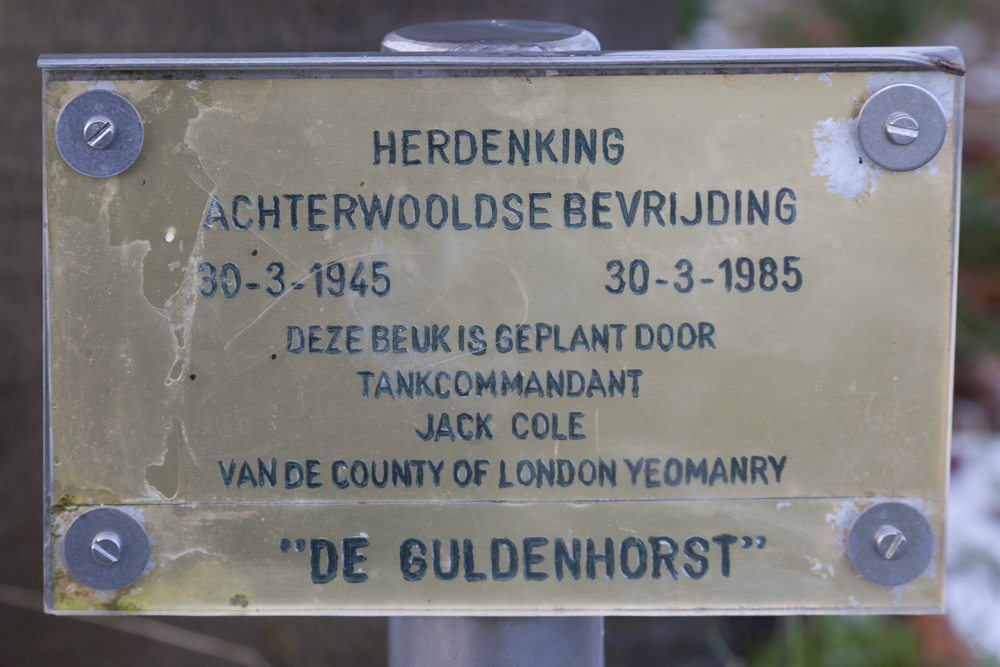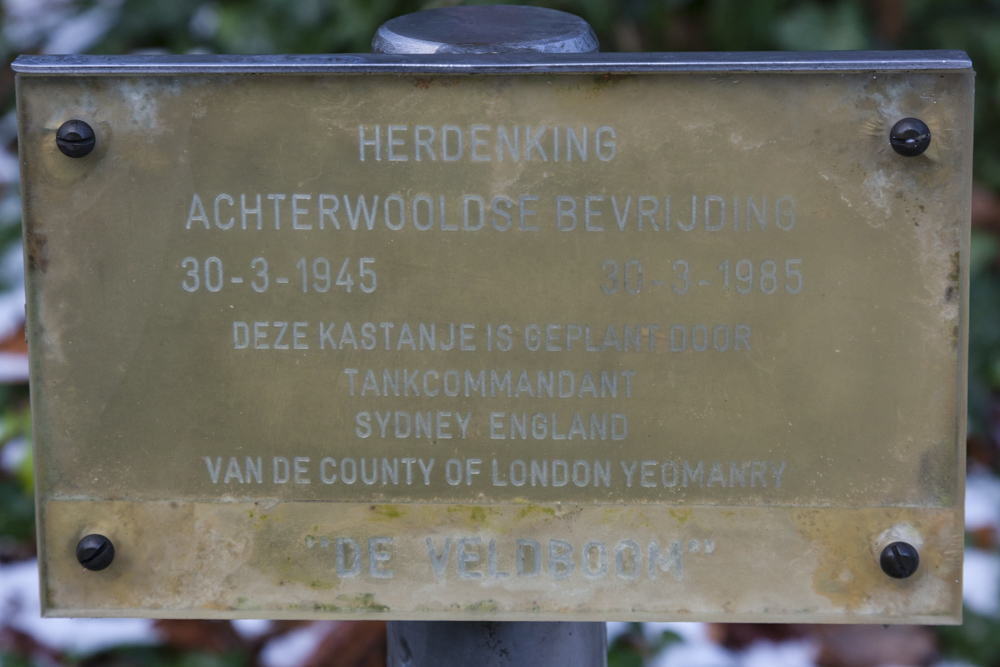Introduction
"Da bunt ze" (there they are)
"Food tourists" and "bread thieves", those were daily words in the famine winter of 1944-1945. A large part of the Dutch population was fighting for its life at that time and: "you had to stand in line to be buried," as a manner of speech. To Allied strategists, this was no reason to rearrange their priorities for the destruction of Nazi Germany. The highest policy makers with the loyal military commanders in their wake were focused entirely on the effective defeat of Berlin. All military capacity, in particular the logistic element was deployed to strike deep and fast into the heart of Germany. In all their plans, the starving nation was literally left at the wayside, the military turning their backs on her.
The motto of London was loud and clear: Only maintaining the initiative will bring us victory and so, we are going to cross the Rhine as soon as possible and then, in one fluid movement out of a strong bridgehead, we will make the jump, over 217 miles long, to the River Elbe. The Chief of Staff at the Supreme Commander’s HQ thought this bridgehead could be established some time in April and that the low lying northwestern area was next in turn. For the Netherlands, in particular the western part, this was the worst possible scenario. This dark picture could fortunately be lit up a little.
"Lucky No. 1" came from Washington: the Joint Chiefs of Staff were deeply impressed by the threatened physical destruction of the Netherlands and ordered Eisenhower (Bio Eisenhower) to devise a plan for the liberation of the western part of the Netherlands. But the condition remained strictly unchanged: cross the Rhine first and establish a strong bridgehead.
"Lucky No. 2" was based on a principle of military strategy: the attacker should always make sure his flanks are protected. In this case, the eastern and northern parts of the Netherlands were the area from which this flank protection was effected. Field marshal Bernard Montgomery (Bio Montgomery) had previously exposed his measures in a plan with the urgent indication: ..the clearing of Holland will take second priority...[1] as soon as problems arise that will thwart the actual goal,
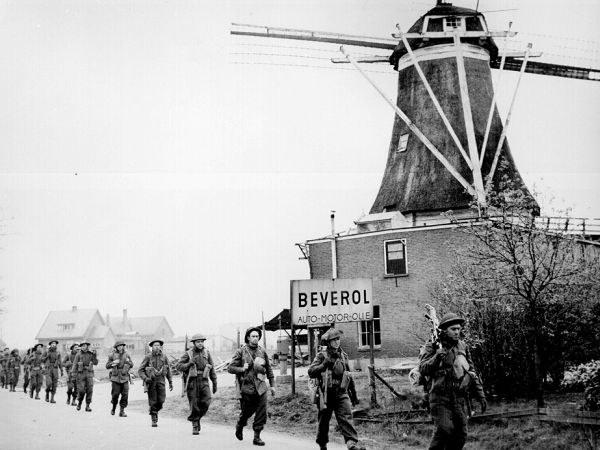
Canadian infantrymen of the Regiment de Maisonneuve advancing from Holten to Rijssen. Source: Wikimedia
This article is about Lucky No. 2, about soldiers and civilians who, in 1945, made the difference between winning and losing, between life and death in the eastern and northern parts of the Netherlands. Years of justice being raped, of misery and terror were relegated to history in March, April and May 1945. The cry "…We are free!..."[2] conveyed indescribable joy. The hamlet of Megchelen, deep in the Achterhoek near Gendringen was the first to experience that joy on March 26th, 1945, brought to them by men of the Canadian 2nd Infantry Division entering from Germany of all places. Near Farmsum, in the Delfzijl Pocket, troops of the Irish Regiment of Canada waged the final battles for the liberation of eastern and northern regions of the Netherlands in the morning of May 2nd, 1945.
It is crystal clear that so many years later, a lot has been written about the liberation of the eastern and northern regions of the Netherlands. This period has yielded well readable and often perfectly detailed documents from primary sources. The intention of this article is to remain modest and this is done by offering a summary of this struggle, in particular emphasizing the connection between these theatres of battle.
Liberation started in the region around Nijmegen and ended via German territory in the western part of Friesland and the northeastern part of Groningen. In this process, two airborne operations played an essential role. The first yielded the requirements for the strong bridgehead mentioned earlier, the second yielded the requirement for a fast, advantageous finale. The first has undoubtedly been successful, the success of the second is subject to discussion.
The chart above shows the general outline of this article. It starts with the break out on February 8th, 1945, followed by the jump across the Rhine in the night of March 23rd to 24th. Next the advance of the Canadians and British out of the bridgehead in the direction of the Achterhoek to the Hoogeveensche Vaart. In the night of April 7th to 8th, the second airborne operation took place over Drenthe and next came the finale in the provinces of Friesland and Groningen which ended on May 2nd, 1945.
This article is limited, as far as the Netherlands are concerned, to the area of the Canadian 2nd Army Corps with a few words added about the Guards Tank Division of the British 2nd Army as far as the liberation of Twenthe is concerned. The liberation of the Waddenislands lies outside the scope of this article.
Definitielijst
- Infantry
- Foot soldiers of a given army.
- marshal
- Highest military rank, Army commander.
- Nazi
- Abbreviation of a national socialist.
- Regiment
- Part of a division. A division divided into a number of regiments. In the army traditionally the name of the major organised unit of one type of weapon.
- strategy
- Art of warfare, the way in which war should be conducted in general.
The stage of the final battle
With strong leaders from different cultures in the top of the Allied Expeditionary Force (A.E.F.) collisions of minds were inevitable but the ranks were always closed ‘after the boss had spoken’ and the final goal was never lost to sight. Neither was it in August 1944.
As far as British Field Marshall Bernard Montgomery was concerned, the moment of the great pursuit had come. The vital Ruhr area could still be captured in 1944 before the onset of winter and then the war would be over soon, provided his Single Concentrated Trust strategy could be carried out[3]. Eisenhower however held on to his Broad Front Concept. First the Rhine between Arnhem and Basel would have to be reached before the finale could begin. And of course, a focal point would be chosen. Both fortunately agreed on "grabbing the opponent by the throat, " not letting go and keep squeezing.
Translated into practice, the broad front entailed offensive, frontal maneuvers by two army groups on a front more than 217 miles wide. In the north, Montgomery’s 21st Army Group and in the south, regardless of where the focal point lay, General Omar N. Bradley’s 12th Army Group.
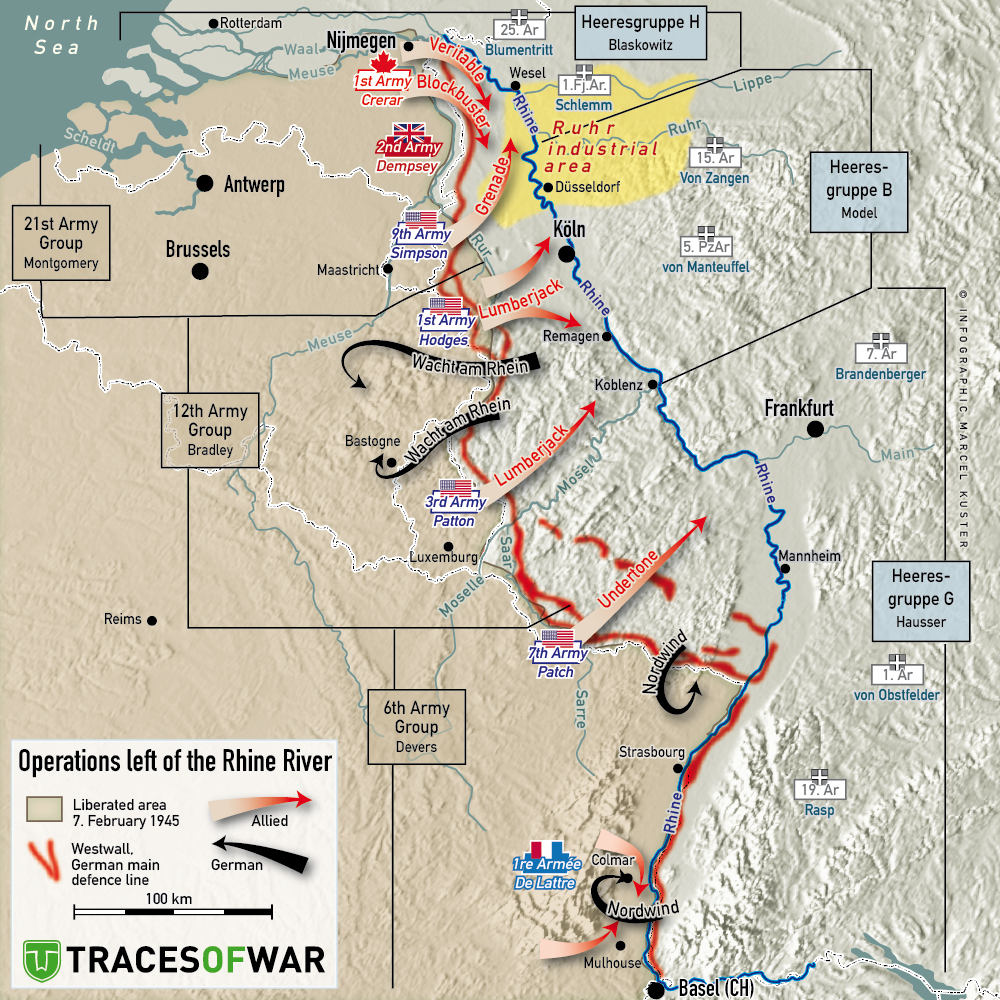
Overview of the front in the last months of 1944 with the focal point north of the Ruhr area. Source: Marcel Kuster, TracesOfWar
This is how the outline would look like with the focal point north of the Ruhr area. In the morning of December 16, 1944, Montgomery presented his strategic plan, code named Veritable. Advanced units of the 21st Army Group were to cross the start line on January 1, 1945 and from then on, only one slogan prevailed for everyone in the army group: we are waging an aggressive, mobile war which will bring us victory. Paralyzed by this operation, the German opponent will have lost the initiative forever and partly due to their lack of fuel, munitions, tanks and transports, they will be defeated soon. Two of our armies will capture the left bank of the Rhine in a gigantic pincer movement. Then we will immediately cross the river and establish a bridgehead with the airborne forces in order to hunt down the opponent deep inside Germany.
At that very moment on German side, four army groups were deployed at the front, including:
- in the north, Heeresgruppe H, commanded by General Kurt Student[4], occupying a front stretching from the North Sea to Roermond, consisting of seven divisions spread over two armies and
- in the center Heeresgruppe B command by Feldmarschall Model, occupying a front from Roermond to the Hondsrug with 36 divisions spread over four armies, including the 6. SS Panzerarmee and the 5. Panzerarmee.
On the same night of December 16, 1944, the Germans launched a strategic attack in the area of the American 1st Army between Monschau and the river Moselle, code named Wache am Rhein. The initial success of this raid endangered 21st Army Group’s left flank. Encirclement had to be prevented in every way possible. The new situation called for new priorities and Operation Veritable faded into the background. Holding on to the Meuse crossings between Liege and Givet "…at all costs… was of the utmost importance.
The situation in the Ardennes remained very critical for over a week but on December 24, the tide turned, this at a moment when the Germans had all but reached the river Meuse between Dinant and Givet. The reason was, 5. Panzerarmee, commanded by General Hasso von Manteuffel was incapable of defeating the American 7th Armored Division commanded by General-major R.W. Hasbrouck. The impregnable circular defense of the Americans near St. Vith[5] proved to be the decisive reason for the German failure. The only thing left to 5. Panzerarmee was to pull back behind the Westwall.
The audacious German counter offensive actually ended on December 26, 1944. As late as mid January 1945, it was mentioned on German side that the "... Fortdauer der Ardennen- Abwehrschlacht ..." (continuing the defensive battle in the Ardennes) was useless and later on it was admitted that "... Die Winterschlacht in den Ardennen am 28.1 zu Ende (ist) gegangen ..."[6] (the winter offensive in the Ardennes has ended on 28.1). The desperation as to a favorable conclusion of their Nazi adventure began to be felt by everyone in Germany in January 1945. The results of over 1 million tons of American and British bombs dropped in the past year 1944 were visible and perceptible.
In the west, the Ruhr area became isolated; the production of steel had dropped with a factor five in six months, the frequency of rail traffic had decreased to well below 50 %, mainly due to a .. Mangel an Kohle und Transport ..(shortage of coal and transport)[7], and the fuel situation led to ..Die PzGrenadiere zu Fuss oder mit Rad bewegt werden .. (the PzGrenadiere have to move either on foot or on bicycles)[8]. Should there be enough material available .. (wegen des Mangels an Munition und Treibstoff nicht auswirken.. (due to the shortage of munitions and fuel, it was useless)[9] . The desperation appeared to have reached even the most insane German. The Führer, shuffling army groups and armies like pawns on a checkerboard, was now at his lowest level. He ordered the establishment of Panzer-Jagd Divisionen (Tank hunters) that ..in kleinen Rudeln eingesetzt werden (als) Radfahr-Kommandos mit panzerbrechenden Mitteln.. (to be deployed in small groups of commandos on bikes, using armor piercing means)[10].
Officially, 112 German divisions were still available for service in the west but those were rather organizational skeletons than impressive fighting units. Later on, the commander of the German 84. Infanterie Division will tell his interrogators that at a certain moment in time, in order to reinforce his division, he had chosen the Magen (stomach) Battalion, rather than the Ohren (ears) Battalion[11]. It says much about the deplorable condition of many German fighting units; but surely that did not apply to all of them as for instance the 2. Fallschirmjäger Regiment with 2,000 trained men and well armed – and there were more of those – were fierce opponents.
On this stage, with freaky and insecure conditions, the Canadian 1st Army had to make an all out effort against the 1st Fallschirmjäger commanded by General Schlemm. Crerar’s troops would achieve this in two phases. He was tasked with occupying the left bank of the Rhine and inflict a maximum of losses on the enemy. In phase 1 the Westwall was to be breached and the line Goch - Calcar to be reached between the rivers Meuse and Rhine. In phase 2 the offensive was to be continued in order to clear the area around Xanten. This would almost fail.
Definitielijst
- Fallschirmjäger
- German paratroopers. Part of the Luftwaffe.
- Führer
- German word for leader. During his reign of power Adolf Hitler was Führer of Nazi Germany.
- Heeresgruppe
- The largest German ground formation and was directly subordinate to the OKH. Mainly consisting of a number of “Armeen” with few directly subordinate other units. A Heeresgruppe operated in a large area and could number several 100,000 men.
- mid
- Military intelligence service.
- Nazi
- Abbreviation of a national socialist.
- offensive
- Attack on a smaller or larger scale.
- raid
- Fast military raid in enemy territory
- Regiment
- Part of a division. A division divided into a number of regiments. In the army traditionally the name of the major organised unit of one type of weapon.
- strategy
- Art of warfare, the way in which war should be conducted in general.
- Westwall
- Also known as Siegfried Line, the German defence line along the German-French border.
Renewed struggle for the initiative
On the west front, it was high time for the A.E.F. to regain the initiative in the sector of 21st Army Group. Plans were drafted and preparations started. The Canadian 1st Army commanded by General Crerar was charged with implementing it all. Weather or no weather, February 8 was H hour, as decided by Eisenhower's HQ. On February 8, the conditions of weather and terrain were indeed unfavorable and the opponent of the Canadian army in its theatre of operation was determined to defend every inch of his territory to the death.
These were the alterations made to Operation Veritable in Crerar’s plan:
- Phase 1: breaking up the forward defenses of the enemy, in other words, clearing of the Reichswald and capturing the line Gennep-Asperden-Cleve,
- Phase 2: breaking through the second defensive line to the east and southeast of the Reichswald in order to capture the cities of Wesel, Üdem, Calcar and Emmerich and securing the connection between these cities and
- Phase 3: overwhelming the Hochwald, mopping up the defensive lines in the rear and occupying the line Geldern-Xanten.
Execution was left to the British XXX Corps commanded by Lieutenant-general Sir Brian G. Horrocks. With five divisions up ahead, of which four on a front 7.4 miles wide and two divisions in the rear, including an armored division, a frontal attack on the enemy was launched. Surprise, fire support and continuous forward movement are the critical factors for success of a frontal attack. Was the British corps able to meet these requirements? The total depth of this area was less than 34 miles (see chart below) without counting the two divisions in the rear.
The Canadian 2nd Army Corps, commanded by Lieutenant-general Guy C. Simonds advanced behind the British army corps and would, provided the width of the front would allow it, take over the forward movement of XXX Corps. The Canadian 1st Army Corps, commanded by General Charles C.B. Foulkes, was to act as a lightning conductor in the vicinity of Arnhem. The opponent was to be kept in the dark as to the real location of the breach in the front line of Heeresgruppe H by misleading maneuvers. The impression was created that Arnhem was the real target of the attack in order to continue the offensive from there.
The commander of the British Army Corps would later voice his amazement as to the successes achieved: "…we did achieve surprise…" but probably the disciplined radio traffic has to be thanked for this mostly:– "..da die Britten Funkdisziplin halten, fehlt bei ihnen entsprechende Folgerung.." and the transports. German long range patrols reported no preparations were discernable for an attack. The conclusion was firm: "…Demnach ist kein Angriff in Holland zu erwarten.."(so, an attack in the Netherlands is not to be expected).
There was little doubt about the fire support everything hinged on. The artillery had build up a majority of 14 to 1 in comparison to the Germans. Some 750 light and 300 medium and heavy artillery pieces were available, not even counting a Canadian rocket unit consisting of 12 rocket launchers, each with 32 tubes and two anti aircraft brigades. Strategic air support consisted of 1,200 bombers, tactical air support consisted of some 1,000 aircraft. There was insecurity about the tactical air support because of the weather. Until February 10, it would be unfavorable for the deployment of close air support: "..Steady rain and fog grounded Allied air support.. The day before the attack, the cities Cleve and Rees got plastered by the strategic air force – almost totally flattened, one might say – and it is peculiar that the O.K.H. does not mention it clearly, just a hint with the remark that an attack ".. mit 80 4-mot. Bombern im Raum von Emmerich und Venlo stattgefunden hat.."[12]
Maintaining the forward movement as the third critical factor for success would depend on various circumstances. Fact was: an extremely unfavorable terrain with insufficient room for mobile attack. These were the geographics: relatively few roads for advance and routes for the divisions, a terrain intersected by small canals and moors, extensive delayed inundations and a high water level; divisions that somehow had to reach their targets over water; dense forests consisting of young pine trees that presented unpleasant obstacles for mechanized troops and secondary and tertiary roads that had become virtually impassable due to the heavy, continuous rain. Scattered across that terrain was a fanatic opponent behind well prepared lines of defense. Villages and ‘Gemeinde" had been transformed to small "hedge hog positions". Moreover, not all Canadians were favorably inclined towards some of their most important leaders. Crerar for instance, was considered "..not a man for clever tactics.."[13], and the judgment about one of his corps commanders was not exactly favorable either because "his subordinates were suspicious of Simonds’ ambitions…[14]". Moreover " ..Colonels and generals had no idea of the German strength..[15]"
Definitielijst
- Heeresgruppe
- The largest German ground formation and was directly subordinate to the OKH. Mainly consisting of a number of “Armeen” with few directly subordinate other units. A Heeresgruppe operated in a large area and could number several 100,000 men.
- offensive
- Attack on a smaller or larger scale.
- rocket
- A projectile propelled by a rearward facing series of explosions.
Operation Veritable
The corps commander’s idea was to penetrate the corridor between Cleve and Materborn as soon as possible after having crossed the start line at 10:30 and then capture Goch immediately. Tactically speaking, the keys to success of this maneuver lay with the corridor and the city of Goch. When the corridor was taken, the road to Goch, but to Xanten also, was up for grabs. The Scottish 15th Infantry Division, reinforced with the 6th Guards Tank Brigade was to launch this main attack. The Canadian 2nd Division was tasked with capturing Wyler and surrounding area just across the start line and securing the road between Nijmegen and Kranenburg. The Welsh 53rd Infantry Division was to capture the high ground to the north of the Reichswald and in a next phase, clear the entire forest of enemies; the 51st Highland Infantry Division was responsible for the western corner of the Reichswald.
As soon as the corridor had been taken, the 43rd Wessex Infantry Division would advance out of the second line and capture the sector of Goch along with the 51st Highlands while the Scottish 15th division would clear the road to Emmerich forthwith and capture Üdem and Calcar. Once Calcar had been taken a pincer movement could be made to occupy the region around Xanten.
Fire support could be provided from all artillery positions up to and including the corridor between Cleve and Materborn without changing positions. A total of 1,034 guns joined in the preliminary barrage that was unleashed at 05:00 hours and continued until the break out, with a five minute interruption in order to lay a smoke screen in front of the Reichswald. Thereafter, continuous close support was provided. The result of this lengthy barrage of suppression and destruction was total disruption of enemy communications.
On February 8, 1945, from 10:30 hours onwards, one of the bloodiest battles of World War One would be unleashed. When the Germans pulled their remaining troops out of the bridgehead near Wesel on March 8, the Canadian 1st Army had suffered almost 16,000 losses, Schlemm’s 1. Fallschirmjäger some 22,000; prisoners of war not counted. A Dutch newspaper had reported previously, although certainly influenced by propaganda, the Reichswald had turned into a mass grave of British soldiers. Maylandwald, an extension, so to speak, of the Reichswald on the road between Cleve and Calcar, was named Slaughterhouse Hill by Canadian soldiers later on. And during the attack on the Hochwald corridor, forward units of the Canadian 4th Armored Division of General-major Chris Vokes literally "..drove into the valley of death..[16]"
In the southern part of the area the terrain consisted of mud, mud and yet more mud, the opponent was extremely tenacious and the own traffic on the roads in chaos because of insufficient space. Whereas at the start a speedy operation was still expected, after the second day the contrary proved true. The soldiers battled against a combination of mud, mines and marionettes. On average, an advance between 3.7 and 4.3 miles took eight hours of fighting. The clearing of mines on the road Nijmegen-Kranenburg, which should have been completed by 16:00 hours, was delayed by five hours due to fierce resistance.
In the northern area soldiers of the Canadian 3rd Division, commanded by General-major D.C. Spry, struggled against a combination of water, mines and a trapped enemy as a result of flooding. More than once they had to wade through three feet of water to reach their objectives. The direction of attacks had to be checked by means of compasses. It failed sometimes.
Yet, it appeared that phase 1 (see chart on previous page) had been achieved at the end of February 9. Appearances were deceptive here though. The 15th Scottish had not yet taken the corridor near Materborn but they were very near. Horrocks interpreted the message about the 15th Scottish far too positively and did not hesitate a moment ordering the 43rd Wessex forward immediately. It nearly turned into a fatal error. From that moment on, massive confusion set in because of traffic jams of vehicles and tanks almost impossible to unravel and also insecurity about the progress. From now on, only emergency tactics and instant solutions could save the day. It took until well into the afternoon of February 11th to open the corridor and Cleve and Materborn were firmly in British hands after ferocious fighting. A counter attack on February 12 by the 47. Panzerkorps was repulsed after 12 hours of combat. 43rd Wessex, on its way to Goch through the corridor, was to wage a fierce battle lasting five days against units of this Korps.
After seven days of battle, phase 2 had not yet been accomplished, Goch had not been captured and the bridge near Gennep was not yet open. Veritable did not proceed particularly favorably. Some space had been created though for the deployment of fresh units. On February 14, Crerar ordered the commander of the Canadian 2nd Army Corps to take over the left flank of XXX Corps in the afternoon of the 15. Simonds’ main axis of attack became Cleve – Üdem, for Horrocks Cleve – Goch – Wesel – Kevelaer; the very same day two battalions of the 15th Scottish had their most unpleasant combat experience since D-Day and the Canadian 3rd Division took over the front from the Scottish. But the lessons had not been learned as Canadian battalions were also sacrificed to this tactically entirely predictable but hardly useful operation. Maylandwald would be deeply engraved on the minds of those Canadians who survived. The forward slope became their Slaughterhouse Hill. The Regina Rifles lost an entire company there, just like the Canadian Scottish and south of the forest, the Essex Scottish were easily overrun by German tanks in a counter attack and the Royal Hamilton Light Infantry became sitting ducks. At last, on February 21, a battalion of the Royal Winnipeg Rifles, supported by tanks and fighter bombers, managed to capture this strip of terrain, suffering losses that amounted to 50 %. The strength of the German defenders had been grossly underestimated and that is something one should never do where marionettes are concerned.
On the same February 21, the original Operation Veritable, that had not even reached its second phase, ended for Crerar. In 14 days time, not yet 21.7 miles had been covered and the Hochwald still was a death defying obstacle for the troops. An important cause of the very slow advance was the high tide on the river Ruhr that impeded the pincer attack by the American 9th Army. This way the Germans could concentrate their efforts on the area of the Canadian 1st Army. Meanwhile, an adapted plan had been drafted, tasking the Canadian 2nd Army Corps with the main effort and Lieutenant general Horrocks’ Corps acting primarily as flank defense for the Canadians.
Definitielijst
- Brigade
- Consisted mostly of two or more regiments. Could operate independently or as part of a division. Sometimes they were part of a corps instead of a division. In theory a brigade consisted of 5,000 to 7,000 men.
- D-Day
- The day of the long awaited invasion of western Europe in Normandy, France, 6 June 1944. After a long campaign of deception the allies attacked the coast of Normandy on five beaches to begin their march on Nazi Germany. Often explained as Decision Day, though this is entirely correct. The D stands for Day as generally used in military language. In this case it means an operation beginning on day D at hour H. Hence “Jour J“ in French.
- Fallschirmjäger
- German paratroopers. Part of the Luftwaffe.
- Infantry
- Foot soldiers of a given army.
- propaganda
- Often misleading information used to gain support among supporters or to gain support. Often used to accomplish ideas and political goals.
- resistance
- Resistance against the enemy. Often also with armed resources.
Operation Blockbuster
".. Bei Kalkar und Goch flauten die Kämpfe ab, .." (Near Kalkar and Goch, the fighting petered out) according to a message by the opponent on February 22nd.[17] Operation Blockbuster was to create a fresh spirit after having been idle for a few days. Implementation was left to Lieutenant-general Simonds and his Canadian 2nd Army. For Simonds, the critical factor for success was the southern part of the Hochwald. The terrain was perfectly suitable for tanks[18] and therefore the main effort was to come from this area. Once the Hochwald had been taken, a fast thrust could be made towards Xanten and Wesel.
What Simonds plan looked like, which he conveyed orally to his divisional commanders on February 22nd, can be seen on the chart below.
An all out offensive on the line Calcar – Üdem and subsequently clear the very strong German defenses in the Hochwald, with the focal point in the south of the forest and the road to the Rhine lay wide open. The corridor between the Hochwald and the combination Tüschenwald, Balbergerwald was crucial. The undamaged railroad between Goch and Xanten had to be prepared to serve as axis for the attack. These were, in short, Simonds ideas.
Previously, the Canadians had had their Slaughterhouse Hill, now the Hochwald Gap would become their nightmare. On February 26th, at 04:30 in the morning, the infantry went into the attack after a preliminary artillery barrage lasting almost an hour. On the right, things were far from easy for the 3rd Division: the terrain offered little cover to the attackers in many places, tanks could hardly move through the mud and the opponents consisted of battle hardened parachutists. Things appeared to proceed more easily for the 2nd Division, followed by armored infantry squads of the 4th Armored Division. Anyway, the road from Calcar via Keppeln to Üdem was reached late in the evening and the North Nova Scotia Highlanders battalion entered Üdem itself on the 27th at daybreak after a fight that had been going on through the night, having started the evening before at 21:00 hours. The same night, Calcar was captured also without any resistance. The requirement for the continuation of Operation Blockbuster was met. The battle for the area between the Hochwald and the Balbergerwald itself could now begin.
For the British XXX Corps, the developments were favorable. At their front, German resistance collapsed in the night of February 26th to 27th and Horrocks’ divisions could continue their advance. Wesel and Kevelaer fell on March 2nd and units of the 53rd Welsh and the American 16th Corps met near Baersdonk on March 3rd. On March 4th, Geldern had been passed and the Welsh and the 52nd Lowlands could continue their advance northeast in the direction of the Rhine, "escorted" on their right by the Americans.
Let’s return to General Simonds’ dream and his apparent passion for the Hochwald. Later on, the Germans would say they had considered this phase of the battle for the Rhineland completely incomprehensible. An advance around the forest would have rendered the perfectly prepared German defense as good as useless, supported as it was though by yards of barbed wire, an elaborate system of dugouts and trenches, some 1,700 mortars and artillery pieces, demoralizing Nebelwerfer launchers, 12 batteries consisting of the notorious 88mm cannon and extremely strong anti tank defenses. Schlemm wanted to exploit this predictable tactic to his own advantage and had no intention whatsoever to withdraw, despite the successes of the British and the Americans.
The weather change on February 28th seemed a stroke of good luck as air support could finally be called in but in the chaos of battle in a relatively small area, close support was hardly possible. In three days time, Simonds had ten battalions, reinforced with tanks advance through the forest and the corridor. The maneuvers between February 27th and March 3rd turned into a "deathtrap for many soldiers and tank crews.."[19] and made the Canadians think of Caen. An officer of the South Saskatchewan Battalion described the situation in another way, using the following event as an example: When prior to a renewed attack, a soldier asked the chaplain for a missal and he reacted by asking if he had not asked for a Protestant Bible the previous day, the soldier answered: "Right you are, Sir but at a time like this I’m taking no chances"[20].
The reversal of the battle should come on March 2nd. The Lake Superior Battalion, after having been in action for four days on end already had as yet to launch a decisive attack by night in order to capture a tactically important area. They were supported by a squadron of tanks and the Algonquin regiment, likewise reinforced with tanks. The Lake Sups deployed their well known Kangaroos but they made hardly any progress in the terrain and for both battalions, the night attack extended into an early morning attack. Severely depleted by the losses and close to exhaustion due to the long deployment, the operation failed and both battalions were decimated.
.. At dawn on March 4th, the Canadians felt defeated – and suddenly triumphant...[21]. Two German divisions, an armored division and a parachutist division were ordered to pull out in order to defend Xanten and the outbreak to Wesel from Genderen. This withdrawal was like a gift from heaven and offered the Canadian 2nd Infantry Division the opportunity to capture and clear the Hochwald. It would take until March 8th though before the attack on Xanten could be launched. On 10:45 hours, the Maison Neuve Battalion in their Kangaroos and the tanks of the Sherbrooke Fusiliers went into the attack. They drove into Xanten without too much opposition. The occupation of the Xanten sector could be completed and on March 9th and 10th, all objectives of Operation Blockbuster had been reached but not before the resistance of the last remaining German forces of the 3. Fest. Division and the 116. Panzer Division on the left bank of the Rhine had been quelled. On March 10th, the Germans abandoned the last bridgehead on the road to Wesel. The crossing of the Rhine could now begin.
Definitielijst
- cannon
- Also known as gun. Often used to indicate different types of artillery.
- infantry
- Foot soldiers of a given army.
- offensive
- Attack on a smaller or larger scale.
- regiment
- Part of a division. A division divided into a number of regiments. In the army traditionally the name of the major organised unit of one type of weapon.
- resistance
- Resistance against the enemy. Often also with armed resources.
- Rhineland
- German-speaking demilitarized area on the right bank of the Rhine which was occupied by Adolf Hitler in 1936 after World War 1.
- squadron
- A military unit in the Belgian navy usually six to eight small ships operating together under one command. The smallest military unit in the Dutch air force of about 350 men. In most countries is the designation of a military unit thesize of a company. It is either an independent unit, such as a battery, or part of a bigger Calvary unit. In the air force it is the designation of a unit of aircrafts.
Establishing a bridgehead
The Rhineland had been captured with difficulty and with luck. After 30 days of bitter combat, the bank of the Rhine had been reached and was firmly in the hands of the 21st Army Group. There had however been no question of a fast and mobile offensive in the area of the Canadian 1st Army. On average, only 500 yards had been covered. Due to the wear and tear however, as a result of the intensity of the fighting, the Germans were unable to launch a counter offensive in any case. They had become too weak and there could be no question of regaining the initiative on a strategic level. Their choice of putting up a defense in the frontal area had turned against them: " .. he cannot escape any longer.. ". There were no longer any sufficiently trained infantrymen left, battalions of the Volkssturm and security forces came to strengthen the ranks by force. Once the ".. Grossangriff über den Rhein hat begonnen.." (the major attack on the Rhine had begun), Hitler even ordered ".. alle Heimatkräfte an die Front geworfen werden.." (all available manpower be deployed at the front).
Meanwhile Von Rundtstedt had been replaced by Feldmarschall Albert Kesselring as ObW (Oberbefehlshaber West, supreme commander). His subordinate Blaskowitz and his Heeresgruppe H, at that moment consisting of 25. Armee, the 1. Fallschirmjäger and a reserve totaling 16 divisions, occupied an area from the North Sea to Duisburg. On average, these divisions were just 4,500 strong, therefore there could hardly be any depth in the defensive belts of the Heeresgruppe, with the exception of those near Rees and Wesel.
The morale of 1. Fallschirmjäger was still high, the physical condition of other units was questionable. Their fire power was fine and their main strength lay in their anti aircraft batteries. There could be no complaining about information on the 21st Army Group though. The Oberkommando (supreme command) had accurate information about the divisions on the Rhine and in the second echelon, including the American and British airborne forces. Their interpretation of the next phase of the Allied advance was not unanimous however; about short term airborne operations it was. Hitler reckoned ".. mit einem Unternehemen im Raum von Arnheim .." (with an operation in the region around Arnhem),,[22] the Oberkommando was certain of " .. die engl. LL-Div.en im Raum von Emmerich landen .." (the British airborne forces would land in the vicinity of Emmerich) and the Americans probably between Bonn and Frankfurt,[23] while Kesselring’s staff ordered the region west of Münster to be guarded in particular as the region would be vey suitable for the coming air drops.[24]
The 21st Army Group crossed the Rhine between Rees and Rheinberg with Dempsey’s British 2nd Army up front on the left and the American 9th Army commanded by Simpson on the right. That was the plan of the 21st Army Group. To Dempsey and his staff, preparation for Operation Plunder must have been very satisfying. The planning staff was granted over a month to deploy the Allied dominance as effectively as possible. With 87 divisions, over 60,000 engineers for the construction of bridges and a logistic system capable of sending 10,000 tons of supplies to the Rhine each day, this enterprise could not possibly fail.
The reasoning behind Plunder was to isolate the Ruhr valley from the rest of Germany. The jump off date for the operation was March 31, later on moved forward to March 24. On March 9th, Bernard Montgomery provided his army commanders with more detailed guidelines for the battle of the Rhine. Wesel was to be the first target and subsequently the bridgehead was to be expanded northward in the direction of Emmerich. After the insertion of the Canadian 1st Army, the 21st Army Group was ready to penetrate deep into Germany from any direction. The Canadians were ordered to protect the left flank of the British 2nd Army and secure the bridgehead at Nijmegen whatever it would take.
In the period between March 10 and 23, the area beyond the right bank of the Rhine was systematically bombed. The railway network was paralyzed to a depth of over 62 miles. In total, over 200 important connections were broken, 80 locomotives and nearly 2,400 rail cars destroyed. In the last few days, the area of the imminent air drops around Hamminkeln were dealt with in order to neutralize the German presence and anti aircraft positions. The relocation of anti aircraft batteries to the area around Bocholt was remarkable. Was this meant to save the batteries from the bombings or were air drops expected in the Bocholt area? In the latter case, the Allies would have learned little from Arnhem.
In the morning of March 24, while he gigantic air armada – 22 miles in length and escorted by 889 fighters and 2,153 bombers – was on its way to Hamminkeln, the village of Brünen was razed to the ground by the British. Around 07:30 hours, the village was plastered by high explosive and incendiary bombs and it continued burning for days afterwards. Brünen, at little more than 6.2 miles from Wesel unfortunately lay on the edge of the landing zone and was an ideal site for artillery and ground forces which could have seriously impeded the air drops. It is cynical to note that the only anti aircraft battery in the village survived the bombing and had its field of fire improved for this one time only.
Brünen is cited intentionally as this is representative of the "face of this war", brilliantly described by Martha Gellhorn[25]. She describes how in April 1945 a flower vendor is selling tulips and narcissus from his cart in a village somewhere on the right bank of the Rhine that is no village any longer. "This man sells flowers," she says, "where there are no more houses to put flowers in". Gellhorn describes the tragedy and resilience of people in a most dramatic way here.
British 2nd Army crosses the Rhine
Dempsey’s operation consisted of four phases:- Phase 1: cross the Rhine with two spearhead divisions – one from each army group – between Wesel and Emmerich, capture Wesel and establish temporary bridgeheads
- Phase 2: Occupy the area west of the railway between Wesel and Millingen
- Phase 3: take and secure the crossings of the Issel between Wesel and Anholt
- Phase 4: advance onto the northern plains in a frontal drive with three army corps, (XXX, XII and VIII) using the cities of Bremen, Hamburg and Lübeck as general points of orientation.
Phase 1:
Cross the Rhine between Emmerich and Wesel with two spearhead divisions. The 51st Highland Division, part of British XXX Corps, shall first advance west of Rees (Operation Turn screw). Lieutenant general N.M. Ritchie, commander of the British XII Army Corps shall sent the 15th Scottish division with two brigades ahead across the Rhine north and south of Xanten and the British 1st Cdo Brigade near Wesel (Operation Widgeon) in the general direction of Hamminkeln (Operation Torchlight). The commandos are to capture Wesel quickly (critical factor of success during the crossing). The British VIII Army Corps, commanded by Lieutenant general Evelyn H. Barker shall follow behind Ritchie and the Canadian 2nd Army Corps, commanded by Simonds shall return to Canadian 1st Army. Later, as soon as the bridgehead is strong enough they shall cut off the German forces in the Netherlands from the direction of Emmerich and protect the flank of the British 2nd Army.Phase 2:
Occupy the area bordered by the railway Millingen – Wesel and the river Rhine; airborne operations between Wesel and Frankenberg by the XVIII Airborne Corps (the British 6th Airborne Division and the American 17th Airborne), commanded by Lieutenant general M.B. Ridgway (Operation Varsity). The airborne forces had been assembled in northern France and eastern England.Phase 3:
Capture and take the crossings of the Issel by paratroops, also restoring the lines of communication with friendly ground forces.Phase 4:
With three army corps (XXX, XII and VIII) towards Bremen - Hamburg - Lübeck.
The critical factors of success for this element of Plunder were undoubtedly accurate navigation across a fast flowing river nearly 547 yards wide; a perfect execution of Widgeon and Varsity and a speedy contact between ground and airborne forces. The crossing began on March 23, 1945, at 21:00 hours after the usual heavy preliminary artillery barrage and bombing by the air force. There was hardly any question of any serious reaction by the German artillery.
In order to ensure accurate navigation a so called Bank Group was available that saw to it that all movements to and across the river were directed correctly. The bank group prevented chaos, strictly held onto its priorities and provided the navigation lights which remained invisible to the enemy. The crossing was carried out very professionally. The first wave, for instance including the 51st Highland took only six minutes to cross from bank to bank. Things did go wrong a few times and some tanks were lost as a result.
Operation Widgeon was launched by four battalions of the British 4th Commando Brigade commanded by Brigade general Derek Mills-Roberts. At 19:00 hours the commandos were ready for their task in the assembly area on the west bank. At 20:00 hours, the preliminary barrage was unleashed, lifted only when the first wave arrived on the enemy bank. At 22:00 hours, the 46th Marines took to the water in their Buffalos first in order to establish and hold a bridgehead of some 437 yards deep for the other battalions. Subsequently, the 6th Commando battalion, the 45th, the staff of the Brigade and finally the 3rd Commando crossed the river. The crossing proceeded without a hitch; thereafter the brigade had to traverse 1.86 miles of flat and open country in order to reach the railway north of Wesel and advance into the town. All battalions reached the center of town by 01:00 hours. Topographic maps were utterly useless: barricades and craters marked the center of town, once filled with buildings. Some side streets were still recognizable as such but as to the rest, every house still standing was ablaze after the 15 minute bombardment by Lancasters that had started at 22:30 hours as planned. There was no more bitter street fighting. 2,000 Germans had been trapped and were forced to surrender. The second critical factor of success had been carried out perfectly.
Definitielijst
- Brigade
- Consisted mostly of two or more regiments. Could operate independently or as part of a division. Sometimes they were part of a corps instead of a division. In theory a brigade consisted of 5,000 to 7,000 men.
- Fallschirmjäger
- German paratroopers. Part of the Luftwaffe.
- Heeresgruppe
- The largest German ground formation and was directly subordinate to the OKH. Mainly consisting of a number of “Armeen” with few directly subordinate other units. A Heeresgruppe operated in a large area and could number several 100,000 men.
- offensive
- Attack on a smaller or larger scale.
- Rhineland
- German-speaking demilitarized area on the right bank of the Rhine which was occupied by Adolf Hitler in 1936 after World War 1.
Operation Varsity
The lessons of Arnhem had been learned and were applied quickly. This airborne operation by two divisions was characterized by a "concentration of efforts". Density and nearness were to characterize this concentration. It was a daring operation as drop and landing zones lay within range of German artillery and anti aircraft batteries. Prior to the drop itself, air force and artillery did everything in their power to silence the enemy within 30 minutes. This aspect of fire support was the first critical success factor. The second was the precision and speed of the drops itself. The two divisions would be dropped simultaneously over a small restricted area, measuring 6.21 by 3.7 miles between the river Issel and the forest of Diersfordt by 1,589 transport aircraft carrying the para troops and 1,337 gliders close to their targets and Wesel where the 1st Commando Brigade was at that moment. The city of Hamminkeln was the center of the zones. Density and nearness were indeed characteristic for this operation.
The sudden and fast vertical deployment at an unpredictable location came as a big surprise for Kesselring and his men. It even diverted attention from the front of the 15th Scottish that initially met fierce resistance in the morning of March 24. The Oberkommando reported an air drop south of Bocholt: "Es scheint sich um die 1. englische Ll-Div. zu handeld" (It appears to concern the 1st English Parachutedivison).[26] The confusion must have been immense and the communication between the front and the staff of 1. Fallschirmjäger definitely insufficient. The O.K.H. informed Heeresgruppre H that on March 25(!) some 1,200 men had landed near Dingden-Hamminkeln and a counter attack had been launched successfully. 50 gliders would have been destroyed and a drop in the rear of the 34. Infanterie Division had been completely neutralized at 13:25 hours.[27] This message had no base in fact but was partly correct in so far as on March 24, the Germans had managed to inflict considerable losses locally.
To the German soldiers and the civilian population, the airborne operation, the largest of World War Two must have been almost surreal. For a few hours, the skies were filled with over 5,500 aircraft, including glides and in a relatively small area, 14,000 experienced paratroops came down in four drop zones and six landing zones; the British and Canadians in the northern part and the Americans in the southern part of the area (see chart below with the times of arrival of the units in the various zones). The weather was bad and foggy.
The British 3rd Para Brigade, 1,920 men strong and the American 507th Para Brigade jumped at 09:50 hours, 10 minutes too early. For the 3rd, this did have nasty consequences because it meant over 30% less of preliminary barrage by their own artillery. Out of 119 aircraft, 70 were damaged by anti aircraft fire, a few of them crashing in flames. Moreover, the remaining anti aircraft batteries were mainly situated in Hamminkeln. The 3rd Para Brigade, including the Canadian 1st Para Battalion did not have an easy time. They immediately lost their battalion commander who was later discovered dead in the trees, still in his jump harness. Shot during the descent. The Americans, because of ground fog, partly ended up in the wrong dropping zones. The 513 Para jumped incorrectly in the landing zone which was intended for the British 6th Airlanding Brigade. The full 507 Para should have landed at drop zone W, but it ended up partly at Diersfordt. The American field artillerymen with their 75 mm howitzers did land well on drop zone X at 10.23 hours.
The 5th Para Brigade proved the professionalism of these troops. Some 1,970 men jumped off within four minutes. Between 10:03 and 10:07 hours the staff of a brigade and three para battalions had arrived over their drop zone. At 10:30, all infantry of both divisions had landed safely, followed by the second shift with the higher cadre, the artillery, reconnaissance units, communications, medical personnel and the heavy material. The last landing zone was reached at 11:55.
Hamminkeln itself was captured by the 12th Devon soon after its arrival and the population was assembled in the two churches and the local pub. The brigades had secured their zones at around 11:00 hours. A German counter attack in the area of the 5th Para Brigade was successfully repulsed. The same day, contact was made with the commandos in Wesel and all designated targets had been reached. Varsity had become a great success and the foundation was laid for the establishment of the desired bridgehead.
Definitielijst
- Brigade
- Consisted mostly of two or more regiments. Could operate independently or as part of a division. Sometimes they were part of a corps instead of a division. In theory a brigade consisted of 5,000 to 7,000 men.
- Fallschirmjäger
- German paratroopers. Part of the Luftwaffe.
- infantry
- Foot soldiers of a given army.
- resistance
- Resistance against the enemy. Often also with armed resources.
Advancing northwards
At the end of March 1945 one of the decisions made at the highest military level was to downgrade the position of Bernard Montgomery to a somewhat more modest level. The honor to play the leading role in the completion of the offensive was not granted to the Viscount of El Alamein but to his rival, Bradley. The new shifting of roles brought the American 9th Army back in the ranks of the American 12th Army Group on April 4th at 0:00 hours. Montgomery and his 21st Army Group had to satisfy themselves with the role of flank protector.
On April 5th, Montgomery was forced to adapt his previous plans. For the Canadian 1st Army, commanded by General Crerar, the order remained: "to clear Northeast Holland (..) and West Holland" That could hardly have been any different as on April 5th, Crerar was already heavily engaged in the implementation of the orders he had received previously. For instance like this:
- Doesburg was already besieged by the Canadians and thousands of citizens hid in their cellars awating their liberation,[28],
- the "Tinus Plotselings" were already in the air over the Achterhoek and Twenthe, busily reconnoitering and directing artillery fire )[29],
- the "Maison Neuves" and the Calgary Highlanders were expanding their bridgeheads on the northern bank of the Twenthe-Rhine Canal and
- scouts of the "Sups" had already entered the eastern suburbs of Coevorden.
On divisional level, the order was shaped in this way:
- At least two divisions would be given the task to liberate the western part of the Netherlands and this would undoubtedly take some time.
- At the same time, the remaining divisions were deployed against the occupying forces in the eastern and northern regions of the Netherlands and subsequently to capture the German northern coastal sector; in connection with this maneuver, an armored division was to protect the left flank of the British 2nd Army on the line Almelo – Meppen – Oldenburg.
- Western Holland retained its status area of second priority in case insufficient means would be available for the other operations.
By operating this way, the German fighting power was dispersed and divided and the coherence was lost. The German withdrawal went literally anywhere and in fact nowhere. The encirclement of Heeresgruppe B in the Ardennes was a fact already. As for Heeresgruppe H, many could still escape, often with the help of many "wrong" Dutchmen. Anything on wheels was mobilized to support the German withdrawal, or rather the escape. Consequently it was of the greatest importance for the Canadian divisions to reach the Waddencoast as soon as possible in order to cut off the remains of Heeresgruppe H and force them to surrender. In particular the Dutch SS men and the child soldiers deployed offered fanatical resistance, apparently because they had nothing more to lose.
Before the Canadians could embark on their task of liberating the eastern and northeastern part of the Netherlands, they still faced a bitter struggle against the tough and highly professional remnants of 1. Fallschirmjäger across the Rhine between Rees and Emmerich. After their lightning like crossing of the Rhine on March 23rd, the spearhead of the 51st Highland Division ran into fierce resistance at the village of Speldrop, northeast of Rees. Friendly forces had been nailed down there and were unable to get away. The Canadian Highland Light Infantry Battalion (part of the 9th Infantry Brigade, itself part of the Canadian 3rd Infantry Division), was ordered to capture Speldrop immediately after their crossing on March 24 at 04:30 in the morning. A bitter fight ensued, lasting until the early morning of the 25th. ".. die Häuser mussten mit dem Bajonett gesaubert werden .. " (The houses had to be cleared by bayonet)[30], the defenders were driven from their positions with flamethrowers and finally, the artillery put an end to all hope of success for the Germans.
On March 25, Horrocks’ British Army Corps was able to extend its sector of the bridgehead and reinforce it with three divisions on the front line; the 43rd Wessex on the right, the 51st Highland in the center and the Canadian 3rd Division on the left. This 3rd had the enormous misfortune to encounter units of the 15. Panzerinfanterie Division in its sector. The Germans were to block the passage to Emmerich at all costs. Everyone knew what it meant if an order like that was given to Germans. It took the combined effort of three battalions to eventually capture the village of Bienen, just 1.2 miles from Speldrop on March 26.
In the late afternoon of March 28, the 3rd Division was returned to the command of Canadian 2nd Army Corps that had launched the attack on Emmerich in the mean time. To be precise: units of this 2nd Army Corps crossed the Landwehrkanal at 22:00 hours on March 28th and went into the attack. The battalions of the Canadian Scottish and Regina Rifles (a company of the battalion by the way), later on supported by the Royal Winnipeg Rifles, captured Klein-Netterden at 03:00 hours in the morning of March 29. Emmerich would firmly be in Canadians hands as late as March 31. Once again, fire support proved to be indispensable. An inhabitant of Emmerich later declared: "In jedem Garten, in jeder Wiese, auf jedem freien Fleck baute man Geschütze auf" (In every garden, in every meadow, on every free spot, artillery pieces were set up)[31].
Meanwhile on March 28, the bridgehead of the 21st Army Group had been expanded to a width of 34.8 miles and on average 19,9 miles deep; construction of bridges proceeded in a very fast pace [32], the units had mutual contact on their flanks and across the whole front, German resistance lessened. The liberation of western, eastern and northern Holland could now be launched. Prince Bernhard’s order to the B.S. (Binnenlandse Strijdkrachten, Interior Forces) was now turned into action. The commander gave order to maintain the strictest discipline ".. in connection with an ongoing operation that can have major consequences,"[33] in other words the liberation of the whole of the Netherlands.
Definitielijst
- bayonet
- Pointed weapon that can be placed at the end of a rifle and used in man-to-man combat.
- Brigade
- Consisted mostly of two or more regiments. Could operate independently or as part of a division. Sometimes they were part of a corps instead of a division. In theory a brigade consisted of 5,000 to 7,000 men.
- El Alamein
- City in North Egypt. The Battle of El Alamein took place from October to November 1942 and was a turning point in the war. The German-Italian advance in North Africa was finally halted by the Allies.
- Fallschirmjäger
- German paratroopers. Part of the Luftwaffe.
- Heeresgruppe
- The largest German ground formation and was directly subordinate to the OKH. Mainly consisting of a number of “Armeen” with few directly subordinate other units. A Heeresgruppe operated in a large area and could number several 100,000 men.
- Infantry
- Foot soldiers of a given army.
- offensive
- Attack on a smaller or larger scale.
- resistance
- Resistance against the enemy. Often also with armed resources.
Liberation up to the Hoogeveensche Vaart
Two obstacles still had to be overcome before the Canadians could advance on the Netherlands at full throttle. The first was the strategically important region Hoch-Elten, some 3.7 miles northeast of Emmerich. From here, the battlefield extended all the way to Emmerich, from where the Germans were able to seriously disrupt the advance and the construction of bridges across the Rhine.
The Canadian 3rd Infantry Division was allowed to take on the Hoch-Elten job. In the night of March 30 to 31, two battalions of the 8th Infantry Brigade, the Queen’s Own Rifles and the Régiment de la Chaudière went on their way. Once again, the artillery let itself be felt. A Canadian army paper reported: ".. Hoch-Elten is one the most destroyed areas of western Europe (..) the earth has been pulverized and all trenches and barracks have been slivered and smashed (..) previously the hills were densely wooded, it is now a skeleton forest, not one tree is left standing (..) destruction was the only obstacle..",[34]. The "Chauds" captured the town of Elten meeting little resistance, the Queens had a more difficult time as they had to fight the German defenders during the whole afternoon and evening and the Queens finally reached the summit of Hoch-Elten on April 1st.
The second obstacle was the crossing near Emmerich. In a short time, three bridges were constructed but not before Hoch-Elten had been captured. The first bridge, suitable for all heavy material could already be used on April 1, the two others soon followed. (The enormous success of the supporting units lies in the principle of centralization. This ensures quick and flexible allocation of material).
The road from Bienen via Millingen to Anholt and Bocholt was a narrow bottleneck, not even 9.9 miles wide through which two army corps had to pass; the Canadian 1st Army Corps of Lieutenant general Foulkes which was in the sector of Arnhem and the British XXX Corps under command of General Dempsey. This high concentration of troops was not good for a fluid start. The 51st Highland Division was to break out of Anholt on March 30 at 07:00 hours but the chaotic traffic caused a delay until the early afternoon. Despite the high density of troops in the sector of the Canadian 2nd Army Corps between Bienen and Millingen, the start did proceed smoothly here.
The Canadian 3rd Infantry Division was deployed on the left flank of the Canadian 2 Army Corps. The ultimate objective of 3rd Infantry was the Frisian Waddencoast, 124.2 miles to the north as the crow flies and with the city of Leeuwarden as its most important target. In the center, the Canadian 2nd Infantry Division was deployed with the city of Groningen as its most important target at about the same distance and it was also tasked with clearing the northern coast of Groningen of enemies and the area on the Dollard in the east as well. On the right of the 2nd Corps, the Polish 1st Armored Division was to advance northward along the line Almelo – Emmen and was to split up past Emmen with the left prong towards Winschoten and the southern bank of the Dollard. The Poles were placed under command of the 2nd Army Corps on April 8. The Canadian 4th Armored Division operated on the left flank of Crerar’s 1st Army and turned near Almelo towards German territory, destination Oldenburg.
The line dividing the Canadian 1st Army and the British 2nd Army ran along the axis Terborg – Zelhem – Ruurlo - Borculo – Delden – Borne – Nordhorn and further north.
The nature of the battle changed drastically, there was no neat front line any more:
- for instance the village of Angerslo, just south of Doesburg, was liberated on April 5, the very same day reconnaissance units had reached the eastern part of the city of Coevorden much farther to the north. Or, to name another example, the village of Wehl, west of Doetinchem that was liberated the day after Ruurlo and Vorden on April 2. Both were at 12.4 miles north of Wehl.
- The advance turned into some sort of relay run in which the stick was passed from the leading unit to the one following. Wherever success was gained, an immediate attempt was made to exploit the situation. Blockades were cleared, then circumvented. The commanders of the brigades formulated the framework. the battalion commanders applied it to their units and the company commanders did the work with their platoons. Relegation went deep; all this to improve speed and flexibility. The conduct of the Canadians is considered a classic example of emergency and improvised tactics which often had the characteristics of the Auftragstaktik attributed to the Germans.
- The liberators hardly bothered about solid protection of their flanks. The Germans could no longer manage to mount fierce counter attacks against a battalion, despite the assumed three divisions in the sector of the Canadian 2nd Army Corps. The German fighting machine, now on the defensive was totally disorganized and the combat structure was broken up. Even a crack unit like the 6. Fallschirmjäger Division had decreased in strength to a doubtful level. Prisoners of war were often "grubby, dirty, slender youth, boys and old men."
The German danger mainly came from small, camouflaged units wanting to hold out tenaciously or snipers and machinegun posts, hidden among the piles of debris and individual soldiers armed with a Panzerfaust who apparently still fostered hopes of being decorated for displayed valor; often 17 year old boys and younger and the Canadians did not always know how to handle them. The advance of the Canadians was also severely impeded by the many streams (In the area of the 2nd Division, there were at least 15 streams of some importance) and the destroyed bridges, which considerably slowed down the advance. Moreover, up to the (Verlengde) Hoogeveensche Vaart there really was too little room to maneuver for both divisions[35]. Therefore, the forward drive was initially left to the 2nd Infantry Division while the 3rd Infantry Division busied itself with the liberation of Zutphen and Deventer.
The starting point of army doctrine was rather straightforward: without fire support, in particular by the artillery, no success and hence little forward movement; in other words: saturate the area, possibly containing the Jerries (nickname for the Germans) the N.S.B. and the Landwacht with fire. Unfortunately however, these Jerries and traitors often were hiding in build up areas or in and near farms and in the end the civilian population suffered most, as always. That the price to be paid for the defeat of the barbarians was high, is shown by the following examples, characteristic of the overall image.
- The bombardment of Doesburg in the night of April 3 to 4 between 01:00 and 07:00 hours ".. we counted 20 exploding grenades per minute:"..[36] the town was plastered by frequent and often merciless artillery fire until April 15 .. "The scope of the Allied barrage was certainly not justified due to the small German presence in Doesburg".. as would be commented later on,
- Dinxperlo; the day before Good Friday the town was as yet ravaged by 37.000 grenades after it had already been liberated:[37] "..smoldering piles of debris, torn off roofs, doors wrenched from their hinges, windows without glass, fluttering curtains etc. If you haven’t seen it yourself, you cannot imagine it
These examples are no exception, by the way. In that corner of Gelderland, many other towns such as Winterswijk, Doetinchem, Zevenaar, Steenderen and Zutphen were severely damaged or a village such as Rha where practically not a single house escaped damage but also outside the build up areas, numerous farm buildings were shot up or incinerated. For instance, the tiny village of Lathum northeast of Westervoort, liberated around April 12, where a few apparently insane Germans set fire to five farm buildings and a house, blew up the Huis te Lathum, all in the last moment and in the process machine-gunned a number of entirely innocent inhabitants of Lathum in revenge.
Sometimes, these situations led to remarkable reactions, such as those reported by Leo Bruil at the liberation of Varsseveld and surroundings:
- During the fighting in Sinderen on March 30, an 11 years old child is hit and says "Father, I have been hit" and the father responds: "Oh boy, keep quiet" but a little later, when the child is picked up, it has passed away. The parents of the child, being Roman Catholics do not allow the (non-Catholic) hearse from Varsseveld to take away their son; it must be done in the Catholic hearse from Silvolde.[38]
- " .. we still do not know whether we are free or not until someone at the entrance to the cellar shoutes: come on out, we have been liberated" It is neighbor L, he is very excited because the war is over but everybody knows he is a member of the N.S.B."
With the exception of the liberation of Doesburg – a siege lasting 14 days – Zutphen and Deventer and the crossing of the Twenthe canal[39] and the fierce German resistance between Almelo and Wierden, the advance up to the (Verlengde) Hoogeveensche Vaart proceeded vary favorably. Sometimes maybe too favorably: "Obviously the Corps or Army plan did not envisage the rapidity of our progress, and even the capture of the Twenthe canal seemed to some low-level observers to have been somewhat ahead of schedule (...) there seemed to be an absence of real "drive" on the higher command: probably for good reasons, such as the considerations of "firming up", "logistics", maintaining communications, and other worthy criteria"[40]Partly because of this, the Germans retreated faster than the liberators could advance. The main problems were the bridges, the congestions creating enormous traffic jams and the mining of roads. "..The Germans were apparently relying mainly on demolitions to hold up our advance.."[41] Most of the time these spots were guarded by small combat teams consisting of a few men armed with Panzerfaust and machineguns. It took time as the situation required a well planned attack and the search for alternative routes in order to let the main force continue its advance. On occasion, a Bailey bridge was constructed quickly, sometimes bridges were hastily repaired, often courageously supported by the local population and on other occasions a temporary bridge was constructed with material available locally. Despite all these delays, the Canadians, British and Poles managed to maintain the speed of their advance pretty well.
The liberation of a village or small community nearly always proceeded along a strict pattern. The sound of shooting coming near, sometimes preceeded by a heavier barrage, the aerial spotter who comes and goes, a villager who had met the liberators earlier on and came back on his bike with chocolate and cigarettes as proof, the excitement while waiting, often in cellars crammed with relatives and fugitives until "da bunt ze" (there they are) could be heard; the feeling of being freed: "..never will I forget that line of soldiers.." but at the same time a disbelieving behavior: "..‘... the undemonstrative Dutch seemed genuinely glad to see us, and although the flag-waving and cheers failed to stir us as they occasionally did in France, we still felt proud to belong to an army of liberation,.." the hunt for the "wrong" fellow countrymen and the restoration of daily order.
The conduct of the enemy also differed from place to place. Sometimes they left in utter silence, sometimes as fast as they could and then again, fierce resistance was offered. The "wrong " acted differently as well: some withdrew with the Germans or tried to flee, probably hoping for better times; others patiently awaited their fate and still others, mainly Dutch SS personnel, first took revenge in the most brutal manner and subsequently resisted till the end, until they literally dropped.
Definitielijst
- Brigade
- Consisted mostly of two or more regiments. Could operate independently or as part of a division. Sometimes they were part of a corps instead of a division. In theory a brigade consisted of 5,000 to 7,000 men.
- Fallschirmjäger
- German paratroopers. Part of the Luftwaffe.
- Infantry
- Foot soldiers of a given army.
- Landwacht
- Armed NSB-members with police authority.
- Panzerfaust
- German anti-tank gun used by the infantry. Consists of a long tube with the grenade mounted at the front side. It was a disposable weapon. After being used it cannot be reloaded. Major disadvantage is the long flame back blast from the tube.
- resistance
- Resistance against the enemy. Often also with armed resources.
Along with the Black Watch battalion
This article is about painting a picture. In this phase of the liberation it is a picture of success and joy and as far as strategy is concerned, it is a picture of the senseless continuation of the war. There was no question anymore of a war on fronts. Hence, painting of this picture continues by tracing the events of one of the Canadian battalions which advanced in the sector of the 2nd Division from Terborg to Hoogeveen. It is the Battalion Black Watch of Canada of the 5th Infantry Brigade. Their war diary is characteristic for the daily events of the battalions.
The route of advance of the battalion ran from Terborg, captured in the early morning hours of April 1st, from the northern edge of Doetinchem to Hummelo (on April 4) and from there to Laren which was the battalion’s target on April 5. From Laren, it went on to Holten April 8, Rijssen 9 and Nijverdal 10 and subsequently Ommen was captured without a shot being fired on the 11th. After having liberated Oud Leusen quickly, the advance continued at the end of the afternoon in the direction of Hoogeveen, the first company arriving at 01:00 hours on April 13. The battalion was to leave for Assen on the same day but more about that later. Measured on the road, a distance of just under 77.6 miles was covered in two weeks. Quite a different experience than the previous one. The meager strength of the opponent was apparent in the – luckily – low number of casualties among the Canadians. Near Terborg five lightly injured in A Company and again in this unit 8 injured and 12 missing during the operations in the north of Doetinchem where the unit got lost for a while. Next during the attack on Laren when C Company and the forward command post of the battalion encountered heavy hostile fire. The men suffered a considerable loss of seriously injured men. Numbers were not reported but it cannot have been high as C Company remained battle ready for a subsequent task. The commander of the battalion, three other officers and a corporal-scout were injured, the latter succumbed to his injuries.
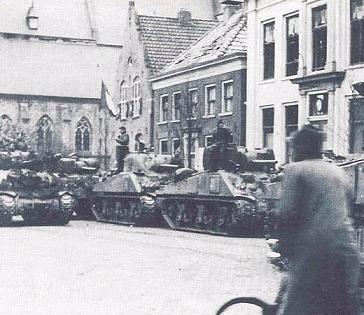
The British main force assembles on the market square in Aalten on April 30th. Source: Bevrijdingskinderen
In the course of this advance, the battalion was continuously reinforced with a squadron of the Fort Garry Horse. The speed of the advance and the mutual distance between the squadrons made it extremely difficult for the commander and his staff to have the command proceed smoothly. The Canadians conducted an impeccable Auftragtaktik without hardly any problems. Their flexibility enabled them to carry out successful actions more than once on platoon level and lower that in the end proved advantageous to the entire battalion and even the level above, for instance the encirclement of the area north of Holten.
Definitielijst
- Brigade
- Consisted mostly of two or more regiments. Could operate independently or as part of a division. Sometimes they were part of a corps instead of a division. In theory a brigade consisted of 5,000 to 7,000 men.
- Infantry
- Foot soldiers of a given army.
- squadron
- A military unit in the Belgian navy usually six to eight small ships operating together under one command. The smallest military unit in the Dutch air force of about 350 men. In most countries is the designation of a military unit thesize of a company. It is either an independent unit, such as a battery, or part of a bigger Calvary unit. In the air force it is the designation of a unit of aircrafts.
- strategy
- Art of warfare, the way in which war should be conducted in general.
Black Watch battalion April 1
This first day is described in somewhat more detail in order to "get the feeling" of the battalion. As always, it begins with the weather, vitally important for any military unit.
This time the weather is fine, cloudy later on. The attack on Tereborg (Terborg is meant here) starts at 01:00 hours, initially proceeding favorably until A-Company (A-Cie) runs into heavy fire of automatic weapons. Fort Garry Horse is asked for tank support, with success; shortly after, the first prisoners are taken "they were a pretty mixed batch" A-Cie again under fire but went forward resolutely, taking the first objective. At a certain moment, two skirmishers go forward stealthily, a German appears who probably had no ammunition left, hits one of the men with the butt of his rifle but ",..the other A-Cie man rolled over and shot the German." Sometimes problems with communication with B-Cie, this time too and so the battalion commander (BC) went forward himself at 04:22 hours to see how Bravo was doing. The company searched house after house but no sign of the enemy. All this proceeded too slowly to the liking of the company commander so he decided to go straight for the target (nearly 500 yards away near the church of Terborg) and the objective was captured without a shot being fired. A medical orderly is bitten in the ear by the injured German he is treating. C-Cie reaches its objective without any resistance. D-Cie comes under very heavy fire in its advance through the forest. One of the platoons manages to disengage itself and makes an encircling movement. D-Cie manages to finish the job and takes prisoners. At 07:25 hours, the Battalion can signal; "Bowline clear," (the codename for the attack on Terborg). The objectives are being consolidated and a rest can be taken. The battalion took 61 prisoners and 11 casualties of its own, one of them is serious. At 12:30 hours, BC has to report to the command post of the brigade for new orders and on his return, the battalion is alerted to prepare for a new attack, this time north of Doetinchem. Start of the advance 14:30 hours, the battalion leaves exactly on time. Hardly under way, we had to pull over to let the other brigades of the division through. We stayed on the spot until late in the afternoon; at 16:50 BC had to report to brigade again in order to receive new orders for the battalion during the advance. We left at 19:00 hours with the tanks of the Garries and our own vehicles with C-Cie riding point. The convoy lost its way. visibility was bad and we ran into problems immediately. Two tanks suffered a direct hit, one of them burned out completely. C-Cie came under heavy fire. Number of casualties: 8, missing 12. C-Cie was allowed to withdraw and regroup.
Definitielijst
- brigade
- Consisted mostly of two or more regiments. Could operate independently or as part of a division. Sometimes they were part of a corps instead of a division. In theory a brigade consisted of 5,000 to 7,000 men.
- resistance
- Resistance against the enemy. Often also with armed resources.
Black Watch battalion April 2 to 6
April 2
This morning the weather is cloudy, later on fine and warm. The battalion was in the vicinity of Laag Keppel where another unit of the 5th brigade had already arrived, the Calgary Highlanders Battalion, making mutual contact extremely necessary but it did not always work out that way. Until late in the afternoon, the objective for the Black Watch remained unclear. In early evening, Black Watch was given its new target: Hummelo.Someone from the local resistance contacted the staff of the battalion and offered his services. He was asked to gather information on the opposition in Hummelo. A presence of some 20 men, he reported. Later it appeared that " The estimated 20 Germans in the area had certainly multiplied." The war diary entrance reads: "and in the town the men had to engage in house clearing. "
Earlier that day, B-Cie had a weird experience: a German officer reached the position of one of our platoons on his bike and when he was stopped, he politely got off his bike but immediately after, he threw two hand grenades into the midst of the platoon. Fortunately it ended well, except for the German.
Probably even more weird was the experience of C-Cie. Civilians warned the commander for two Germans hiding in a cellar but the company commander did not wish to waste time on these two. At the moment he started to drive off, both Germans emerged from their hiding place, jumped into the major’s jeep and demanded to be treated as prisoners of war from then on. It goes without saying, this time things turned out well for those two.
The battalion had already captured four targets within 48 hours and was badly in need of sleep.
April 3
Today a warm and sunny day and apart from the security patrols, the men could rest, wash and clean up.In the morning, 4th Infantry Brigade passed through the assembly area of the battalion, on its way to the Twenthe canal in order to establish a bridgehead.
April 4
Orders could often change quickly. This day was no different. At 18:00 hours, orders came through to relocate to Noordink, just north of Hengelo (Gelderland), start at 18:20. On arrival in the new assembly area, the order came to cross the Twenthe canal and capture Laren. Meanwhile, two other battalions of the brigade were ordered to reinforce the bridgehead. Late in the evening, the Black Watch crossed the canal southeast of Laren and moved into in area, awaiting the attack on the village.April 5
At 01:00 the battalion commanders received the new order from brigade. The Maison Neuve is to expand the bridgehead northwards, the Calgary Highlanders to the east; the Black Watch, reinforced with a squadron of Fort Garry Horse passes through the Maison Neuve and captures Laren on the fly.At 07:45 the Black Watch departed with two companies in front in order to take up positions close behind Maison Neuve. Hardly on their way, the two forward units came under heavy hostile fire from snipers and anti tank guns. Obviously, Maison Neuve was not there where the Black Watch had expected them to be. The attack had to be abandoned, they had to withdraw and dig in. C-Cie suffered a few heavy casualties and the staff of the battalion paid too. The battalion commander, one of the casualties himself, was temporarily replaced by one of the company commanders. The replacement proceeded quickly and without a hitch.
Another plan was drafted quickly with again a key role for the artillery. A heavy barrage from light and medium guns on Laren was to pave the way for the first two companies that were to enter Laren. The attack was launched at 11:15, at 16:00 hours, the town was firmly in our hands and the retreated Germans were hiding somewhere in the woods beyond Laren.
April 6
Cloudy weather. A new battalion commander was appointed and reported to Black Watch. In the morning, the Fusiliers du Mont Royal of the 6th Infantry Brigade passed through the area of Black Watch.The day was spent in maintenance, replenishing material and regrouping. Somewhere on the edge of the village in a pub hit by artillery fire, a movie was shown for C-Cie which had to recuperate from the losses suffered.
Definitielijst
- brigade
- Consisted mostly of two or more regiments. Could operate independently or as part of a division. Sometimes they were part of a corps instead of a division. In theory a brigade consisted of 5,000 to 7,000 men.
- Infantry
- Foot soldiers of a given army.
- resistance
- Resistance against the enemy. Often also with armed resources.
- squadron
- A military unit in the Belgian navy usually six to eight small ships operating together under one command. The smallest military unit in the Dutch air force of about 350 men. In most countries is the designation of a military unit thesize of a company. It is either an independent unit, such as a battery, or part of a bigger Calvary unit. In the air force it is the designation of a unit of aircrafts.
Black Watch battalion April 7 to 13
April 7
Cloudy and rainy. A day of rest for the battalion. Later in the afternoon, the order was received to relocate the next day and select a target in the sector of Holten (the target was given the code name Benz). In the afternoon and evening, movies were shown.
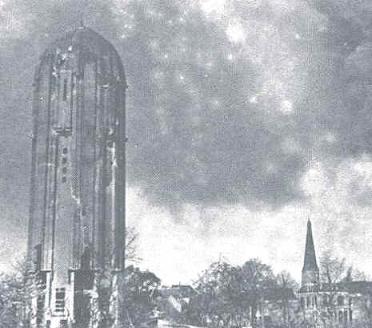
April 8th: German snipers in the water tower on the Warnveldseweg in Zutphen had to be silenced. Source: Bevrijdingskinderen
April 8
A Canadian carrier drives into Holten, liberated on April 9th. Foggy and cold, later in the day the weather turned nice and warm. The battalion departed at 06:45. The leading battalion (Calgary Highlanders) had reached its target in the meantime and Maison Neuve passed through on its way to its own target. Towards 09:00 the leading C-Cie of the Black Watch stood ready to lead the attack on Benz. Resistance was encountered and progress was cautious to keep losses in our own ranks as low as possible. Towards 12:45 the enemy had to give way under pressure by the Canadians but sniper fire remained dangerous. Only after necessary information gathered by patrols it was decided to enter Holten in early evening with two companies, reinforced with tanks. That occurred at 20:00 under heavy fire and once in town, the success was exploited and targets were taken, initially allocated to Maison Neuve.April 9
Fine and balmy weather and again a day of rest, for the necessary maintenance and logistic activities as well. At 20:00 relocation to Rijssen that had been liberated by the Maison Neuves in the morning. On the 10th, the battalion would continue its advance northwards. Ommen was to be the next target.April 10
Once again fine and sunny weather. Black Watch took off at 07:30 with C-Cie in the lead, sitting on the tanks of the Garries and our own vehicles. The day was filled with overcoming water obstacles. First the crossing of the Overijsselsche canal, achieved by means of a small ferry dug up by local people who assisted the Canadians in this crossing. The tanks could not cross and had to wait six hours before a new bridge had been constructed, massively supported by the population. Plans were revised again. At 18:00 hours the next obstacle was encountered, the canal between the Vecht and the river the Regge near Nieuwebrug. Across a small foot bridge, discovered by men of A-Cie, the battalion proceeded on foot and this operation alone took nearly two hours.The battalion had almost reached its target but the order came from brigade not to advance any further. All night long, patrols were intensive. A loud explosion made it seem like the bridge spanning the Vecht near Ommen had now been destroyed. Enemy mortar fire not worth mentioning.
April 11
Weather unchanged. Early in the morning a reconnaissance patrol of C-Cie left for Ommen and reported only slight damage to the bridge: no more than a hole, three feet across in the center of the bridge. The patrol entered Ommen and encountered two German soldiers on bicycles who were fired at immediately. Reaction on the report of the patrol was immediate: C-Cie went ahead with bulldozers and tanks and reported not long after: "town cleared" Ommen had been liberated and the battalion took up positions west of the town in the vicinity of Varsen.April 12
Weather calm and cloudy. Intelligence reports indicate hostile activities at 3 miles west of Ommen in Oud Leusen. A-Cie, reinforced with a self propelled gun and three 3 inch mortars was going to take on this job today. Just after 15:00 hours, contact with the enemy was made and Oud Leusen was liberated in the blink of an eye, so to speak. The Alfa returned with 18 prisoners of war and remained free from losses itself.At 17:00 hours, the battalion received a warning from brigade that the Black Watch would not be relocated temporarily. At 20:00 the order came down from by brigade to depart for Hoogeveen immediately. The Black Watch was to prepare and launch a counter attack to eliminate the threat to Hoogeveen from the west. Earlier on, a resistance fighter from Zwolle had reported to the battalion with an important message for the brigade. As Meppel had not been liberated yet on this day, it seems that this information concerned a possible attack from the direction of Meppel on the open flanks on the Canadian 2nd Division which was advancing northwards. Another possibility is that the camp Ten Arlo, in the direct vicinity of Meppel, still housed a number of fanatic SS men who were ready to fight to the bitter end[42].
Just before departure to Hoogeveen, an attack from the west would also be imminent in the sector Ommen. It was a message from a civilian. Brigade ordered the Black Watch to leave one company behind (A-Cie) which was to contact Maison Neuve to take over the sector. For A-Cie, no transport was available any more and they simply had to wait on the route of advance for transport if and when available. The result of this improvisation based on "a message": no enemy appeared with an attack, there was no enemy in the vicinity, Maison Neuve had already left and no contact had been made, the night was dark, moonless and cold and for the time being, transport did not materialize. The company had to wait for a long time, some three and a half hours.
April 13
Weather fine and sunny again. Black Watch arrived in Hoogeveen at 01:00 hours and could greet its unfortunate A-Cie at 04:20. Meanwhile no attack from the west and the battalion was ordered to leave for Assen in the course of the day. At that moment, the 6th Brigade was already fighting north of Assen and 4th Brigade had received orders to attack Groningen from the south. In case resistance should prove to be too heavy the 5th Brigade, including the Black Watch, was to quell the resistance from the west.The Black Watch left at 15:15 via Muil, Spier, Beilen and Hooghalen. More about this battalion in a later chapter.
Definitielijst
- brigade
- Consisted mostly of two or more regiments. Could operate independently or as part of a division. Sometimes they were part of a corps instead of a division. In theory a brigade consisted of 5,000 to 7,000 men.
- mortar
- Canon that is able to fire its grenades, in a very curved trajectory at short range.
- Resistance
- Resistance against the enemy. Often also with armed resources.
- sniper
- Military sniper who can eliminate individual targets at long distances (up to about 800 meters).
Hoogeveen in the center of the Hoogeveensche Vaart
When the Black Watch had yet to capture Ommen on April 11, other Canadian units were already standing just south of the Hoogeveensche Vaart near Hoogeveen close to the town but the previous day, Belgian paratroops (more about those in the next chapter) had already initiated the liberation of the town. A mobile combat patrol drove into Hoogeveen at 10:00 in the morning along the Coevorderstraatweg as far as the Noordse Brug, took four German prisoners and departed again as fast as they had arrived. Yet, this is"..the moment Hoogeveen feels liberated .."[43]. In the eastern part of Drenthe, events unfolded even more favorably. The Polish Division liberated Zweeloo and Sleen as early as April 9th and moved in the direction of Groningen.
In the west, Meppel had not yet been freed of the German occupier but in the east, Coevorden celebrated its liberation as early as April 5 and 6. A fine example of the whimsical and bizarre course of the front line: as Meppel was liberated on April 13 by D squadron of the 12th Battalion Manitoba Dragoons and two men were still executed; the 4th Infantry Brigade was already attacking Groningen from the south, men of Maczek’s Polish Armored Brigade had reached Boertange, Zwolle was not yet relieved – that was as late as April 14, in Wolvega the flags were already flying and units of the Canadian 3rd Infantry Division had advanced deep into Frisian territory.
In Coevorden the Germans still attempted to resist and it took the Canadians all of the afternoon and the next morning to eliminate this cluster of opposition. The Bentheimerbridge, which had been blown up, prevented the liberators from achieving their goal quicker. In Hoogeveen, the German commander wanted no confrontation with the Canadians, at the same time when Hitler’s "forces of last hope", consisting of some 2,000 men had settled in Hoogeveen. These "Volksstürmer" however were completely disorganized and demoralized and dozens of them deserted.
In consequence, Hoogeveen was captured with hardly any problems. The whole operation proceeded so smoothly that the municipal administration did not even know all the ins and outs. The response to a letter from the Department of War about the liberation read: "..Hoogeveen has been liberated by the 1st Canadian Army passing through on its way to Assen; name of commander unknown.."[44] There also was minor damage in Hoogeveen and surroundings. The Organisation Todt had actually carried out demolitions and here and there there had been question of agricultural exploitation by removing the live stock. In the end, restoration of the blown bridges yielded a loss of exactly 1,143.96 Dutch guilders. Even less was the damage caused by the Germans to the Church of Our Lord, which is evident from the response of the minister of this church from a letter to the mayor: "..The German Wehrmacht has only taken two garden rakes from us .."[45]. The largest obstacle for a speedy and definite liberation was the construction of an emergency bridge near the Griendtsveenbrug. Luckily, a creative sergeant of the engineers was on site and by coincidence also sufficient railway sleepers and wood so the bridge could be constructed in a single day. At 19:30 hours of April 11, the Canadian spearhead turned up to liberate the final stretch of Hoogeveen territory.
On April 8, General Christiansen and his staff silently left Emmen. From that moment on, the defense of the Hoogeveensche Vaart was delegated to General D. Böttger, commander of Feldkommandantur 674 in Groningen. His forward command post was situated in Hotel Slomp in Westerbork. Böttger faced an impossible task. Between Holsloot and Hoogeveen, a distance of 16 miles, the Vaart was to be defended by three companies of 115 men each. They possessed neither artillery nor heavy weapons, only Panzerfauste. Böttger’s reserve consisted of 28 men on motorcycles. Their task: to launch counter attacks between Hoogeveen and Assen, wherever necessary. Such a defense of course is a strategic joke. The S.A.S. units in Drenthe also had to face these forces.
Things could only proceed well and "..home seemed very close indeed.." as can be read in the war diary of the Fort Garry Horse.
Definitielijst
- Brigade
- Consisted mostly of two or more regiments. Could operate independently or as part of a division. Sometimes they were part of a corps instead of a division. In theory a brigade consisted of 5,000 to 7,000 men.
- Infantry
- Foot soldiers of a given army.
- squadron
- A military unit in the Belgian navy usually six to eight small ships operating together under one command. The smallest military unit in the Dutch air force of about 350 men. In most countries is the designation of a military unit thesize of a company. It is either an independent unit, such as a battery, or part of a bigger Calvary unit. In the air force it is the designation of a unit of aircrafts.
- Wehrmacht
- German armed military forces, divided in ground forces, air force and navy.
Special Air Service (S.A.S.) Drenthe
In general
[46] It was a near thing that paratroops were actually dropped over Drenthe at all. Fortunately Brigade-general J. Michael Calvert, fresh from Burma, accepted command of the Special Air Service Brigade. Disbanding the S.A.S. unit was a serious subject for discussion and Calvert was tasked with showing that the brigade could really play a significant role. He was granted a few weeks to demonstrate the value of these paratroops. It could be entrusted to him as Calvert was a pupil of the legendary general-major Orde Wingate, "father" of the famous Special Night Squads, a Jewish legion of the 30s that had been taught by Wingate how to wage guerilla warfare. Calvert had wholeheartedly adopted these guerilla tactics and techniques in the Burmese jungle, albeit with mules and ponies. He knew what was meant by skill, adventure, passion, daring, risks, power of adaptation and insecurity.In a letter of March 21, 1945, the very day Calvert was officially placed in command of the S.A.S. Brigade, he openly argued there still was a lot of valuable work to do. Inspiring as "Mad Mike Calvert" was, he must have imbued his men with many of his characteristics. He expected a well thought of audacity, perseverance and speed from them. These characteristics did not mean luck for everyone. Innocent civilians have been cornered more than once and some of them have paid with their lives. The monument at Spier is a silent witness to it.
The Canadians had no S.A.S. units of their own and when General Crerar heard about a possibility to deploy the S.A.S. in the sector of his 1st Army (the proposal came from the 21st Army Group on March 28), he did not hesitate a second. On March 30t Calvert and Crerar discussed plans for the deployment of airborne troops on Dutch territory. Early April it was decided to launch three separate operations. An all ground operation (code name Larkswood) in connection with an airborne operation in Drenthe (Operation Amherst) and a separate airborne operation in support of the advance in the west, code named Keystone.
Larkswood was carried out by the Belgian 1st Parachutist Battalion commanded by Major Blondeel. Their task was to carry out special reconnaissance and combat patrols in northeastern Holland. Initially the battalion was placed under command of the 4th Canadian Armored Division and shortly after under command of the Polish Armored Division.
Operation Amherst was carried out by the French of the 2ième (later 4 S.A.S.) and the 3ième (later 3 S.A.S.) Régiment de Chasseurs Parachutistes (R.C.P.) commanded by Major Puech-Samson and Lieutenant-colonel De Bollardière respectively. Their task entailed capturing the airfields near Steenwijk, the second priority was securing the crossings on the route of advance. A secondary task was causing chaos among the German ranks and guiding and providing intelligence to forward units.
On April 7, the Belgians took over the defense of strategically important Coevorden from the Canadians and were ordered to perform offensive reconnaissance ahead of the Canadian 4th Armored Division. Less than 24 hours later, in the night of April 7 to 8, two French battalions were dropped over Drenthe. They were tasked with causing chaos in the German ranks. Calvert wanted them to be seen, the reason behind not burying their parachutes after landing. Did these Belgians and French come as an afterthought since the advance of the Canadians continued as desired? Where were the divisions of the Canadian 2nd Army Corps at that time? What was the situation like on April 7?
The situation
[47]Major-general A.B. Matthews wanted to expand the bridgehead on the Schipbeek canal with his 2nd Infantry Division beyond the line Laren – Holten. The area around Holten was meticulously reconnoitered. Major-general R.B. Keefler and his 3rd Infantry Division were still fighting in the vicinity of the river IJssel and concerned themselves with Deventer and Zutphen. Major-general Vokes was already busy clearing the surroundings of Meppen in Germany with his 4th Armored Division. His front line ran from Meppen via Coevorden to Almelo and Delden. Therefore, the corps commander wanted to get the triangle Almelo – Borne – Delden firmly in his hands and at the same time have one of his brigades in reserve for the crossing of the Eems at Meppen. Moreover, on this April 7, the Polish Armored Davison was to arrive in order to strike northeast on the right flank from the sector Coevorden. On the left flank, the 3rd Division had to finish the job at the IJssel quickly and then strike out towards Zwolle.
How about the Germans?
They had demonstrated their willingness to fight for Zutphen, Doesburg and other places until they dropped. But in general, the power of resistance of the German units had collapsed. From April 7 onwards, the only serious obstacle was in northwestern Germany on the Eems. The speedy advance on the right flank of the Canadian 2nd Army Corps had the Germans totally confused. In a way, Drenthe had become an empty shell. Later on, General Eugen Meindl, commander of the 2. Fallschirmjägerkorps, would state that not a single strategic plan existed anymore as to how to conduct the defense. His 6. Fallschirmjäger Division may still have been in the Netherlands but had lost all contact with the army corps. The commander of this division, Generalmajor Hermann Plocher stated he had been maneuvered into a very precarious situation by the advance of the Canadian 4th Armored Division. He was forced to split up his division and have one part retreat westwards beyond the IJssel and another part northeastwards. He was fortunate however to be able to execute these maneuvers, so the general said, because the tactics of the Canadians were entirely predictable, not only in space (how to occupy the area and with what) but even in time. This enabled his division to regroup and consolidate in time on each occasion.The morale of the German soldier was relatively low and they were generally tired of the war but it was expected that the way of life of the Nazi soldier was one of continuous fighting till you drop. The recent battle for the Rhineland had clearly demonstrated this attitude. The German military adagium: "Gehorsam ist Prinzip, aber der Mann steht über dem Prinzip" (The principle is obedience but the man stands above the principle, a quote of Feldmarschall Helmuth von Moltke) had not been applicable for years to many German commanders. This principle was certainly not applicable to Dutch SS soldiers and young air force cadets (in Drenthe there was a training unit for these soldiers) and the expectation of fanatic and senseless resistance was entirely justified. The older men were more than fed up with it however and found out they had been misled. It could be said that the conduct of the opponent in general had become unpredictable. In a situation like that, with a predominantly clustered resistance, localized, possibly bitter engagements on company, platoon or individual level emerge all too easily. In the over all picture, these localized and ferocious actions were hardly important. For the individual soldier and civilian who were confronted directly with them they surely were.
Definitielijst
- Brigade
- Consisted mostly of two or more regiments. Could operate independently or as part of a division. Sometimes they were part of a corps instead of a division. In theory a brigade consisted of 5,000 to 7,000 men.
- Fallschirmjäger
- German paratroopers. Part of the Luftwaffe.
- Infantry
- Foot soldiers of a given army.
- Nazi
- Abbreviation of a national socialist.
- offensive
- Attack on a smaller or larger scale.
- resistance
- Resistance against the enemy. Often also with armed resources.
- Rhineland
- German-speaking demilitarized area on the right bank of the Rhine which was occupied by Adolf Hitler in 1936 after World War 1.
Operation Larkswood
The Belgian S.A.S. unit, a little over 140 strong, had really earned a reputation for itself after its first deployment in the vicinity of Perche in France on August 8, 1944. Two small groups, Regan and Gobbo, even participated in Operation Market Garden, albeit indirectly. Their dropping, far behind enemy lines in Utrecht and Drenthe, should provide the necessary information for Bernard Montgomery’s HQ. And in October 1944, a team of four was dropped over Friesland to train Dutch resistance fighters in the use of light fire arms. Still later, Corporal Raymond Holvoet would be dropped to establish a communication network. He was injured and arrested by the Gestapo. Despite a few months of sustained torture, Holvoet revealed nothing and for this reason he was executed on April 10, 1945 and dumped into the Ijssel.
In October, the unit relocated to Tervueren and was converted into a long range reconnaissance unit in the strength of a squadron (a total of 132 men including 12 officers). The composition of this unit was simple and effective: a mobile command post, a medical team, a few 3 inch mortar teams, wireless teams, engineers, a repair and maintenance crew and two sections with a total of 100 vehicles, half of those armored. The vehicles were armed with Vickers heavy machine guns. The training was aimed at acting independently and offensive reconnaissance. The unit increased steadily to a complement of 300. It cooperated closely with the intelligence section of the 21st Army Group.
From Coevorden, the Belgians entered no man’s land with their reconnaissance teams south of the Verlengde Hoogeveensche Vaart between Coevorden and Hoogeveen. They quickly went about their business. As early as April 7, a Belgian group reconnoitered and patrolled the Verlengde Hoogeveensche Vaart and entered Hoogeveen along the Coevordenseweg, took a few prisoners and headed for home again in the direction of Coevorden. Naturally such patrols were noticed and the tension among the population grew. People awaited events and did not know what was going to happen until two patrols drove into Elim in the afternoon of April 8, one from the direction of De Krim, the other one from Slagharen. The tide finally seemed to turn but as speedily as they had arrived, just as speedily they departed again. The joy of the inhabitants switched back to insecurity. Flags were stashed away once more. And sure enough, a little later motorized Germans turned up again. On April 10, the Belgians returned but this time to clear the area from Germans and the German minded once and for all, greedily supported by members of the local B.S. The day after, Noordscheschut and Nieuweroord were liberated as well. That day, hordes of Germans fled in panic or surrendered without offering any resistance. The story goes that a single soldier in a single jeep liberated Noordscheschut and "it was a Belgian, no less"[48]. And as it was, the Belgians liberated the better part of Hoogeveen on April 10.
Not everyone had noticed these Belgians. It is said that Hollandscheveld was liberated the day before Hoogeveen without a single soldier having been seen. The Germans had left silently in the previous night and a lone journalist came to tell Hollandscheveld had been liberated.
The reconnaissance patrols from De Krim to Slagharen and Hardenberg were part of the task to secure the line of communication with Vokes’ division. After the dropping of the French, the Belgians were given yet another task: contact the R.C.P.s straight through the German lines and take the wounded parachutists to safety. This task was also carried out perfectly by Blondeel’s men. They went as far as the Oranje canal in northerly direction and up to Dedemsvaart in southwesterly direction and took their wounded French colleagues home safely. This for instance occurred on April 8 where a stick had inadvertently jumped off near Dedemsvaart, afterwards on April 9 where contact was sought and made with French paras in a forest near Witteveen who reported three dead and one missing but were not in need of help and finally on April 11 when wounded French were evacuated from the Oranje canal.
On April 10, the chain of command was changed and the Belgian S.A.S. was placed under command of the Polish general Maczek. They became the eyes of the Polish Armored Division and they immediately earned their salary by capturing the bridge at Oosterhesselen by surprise. This meant massive time gained for Maczek’s division. The paras immediately struck out towards Winschoten and encountered fierce resistance by units of the Kriegsmarine at the Veele bridge. Half a day of bitter fighting and a "swimming exercise" to cross the canal eventually led to the establishment of a bridgehead and a decrease of German fighting power by more than half.
On it went to Blijham across virtually unprotected terrain. The enemy had set up a defensive line beyond the Pekela canal and the bridge at Winschoten was also heavily defended, supported by artillery and mortars no less. At that critical moment, Calvert himself was present and personally called for close air support by Typhoons armed with rockets. The request for their deployment was transmitted in plain language and within 30 minutes, resistance had all but disappeared. A smokescreen by our own artillery following the attack by the Typhoons finally enabled a jeep section to break through and force the German to withdraw. Winschoten was liberated in the early hours of April 15. Further they went at breakneck speed in the direction of the coast which was reached the same day and near Beerta, a pocket of resistance that had been left behind was completely neutralized. As far as Dutch territory was concerned, Larkswood was over. The Belgians did play an essential role in the liberation because of their speed, their skill and their resolute conduct.
Definitielijst
- Kriegsmarine
- Germa navy. Part of the Wehrmacht next to Heer and Luftwaffe.
- mortar
- Canon that is able to fire its grenades, in a very curved trajectory at short range.
- offensive
- Attack on a smaller or larger scale.
- resistance
- Resistance against the enemy. Often also with armed resources.
- squadron
- A military unit in the Belgian navy usually six to eight small ships operating together under one command. The smallest military unit in the Dutch air force of about 350 men. In most countries is the designation of a military unit thesize of a company. It is either an independent unit, such as a battery, or part of a bigger Calvary unit. In the air force it is the designation of a unit of aircrafts.
Operation Amherst
Was it a questionable honor for 2 R.C.P. (3 S.A.S.) and 3 R.C.P. (4 S.A.S.) to jump over Drenthe and participate in this last airborne operation of World War Two, Operation Amherst? When the obstacle of the Rhine had to be overcome, they were not there. Their mission was canceled at the last moment. Did the letter in which the new S.A.S. commander Calvert stated there was a lot more work to be done concern this mission? Or was a formula found later on to disable a less than warlike opponent in such a way that he was no longer able to launch threatening counter attacks on the left flank of the Allied advance? In this case, parts of the 6. Fallschirmjäger and a Dutch SS division were meant. Would these soldiers give up the struggle without much resistance? There was no longer any question of coherence and the Germans could completely forget the word strategy for their fighting power, or rather what was left of it, was based on a local play-it-by-ear tactic.
When Calvert addressed his men on April 5, some sort of justification was added. Without this operation, clearing this part of the Netherlands would become a lengthy and costly affair. A remarkable argument, in particular because just prior to departure, the planned drop zone in the vicinity of Coevorden had to be changed because of the speed of advance of the right flank of the Army Group. Moreover, it would appear later on that the sequence of priority objectives had been turned around. Hence a lot of questions to which there can never be a straightforward answer but those keep nagging nonetheless. Fact is that the airborne operation in Drenthe, which would be carried out by some 700 men, had to be prepared in a matter of days. Time was so short that many automatic weapons could not entirely be degreased before they were packed into the containers. This caused jamming on firing with sometimes dire results such as for instance during the fighting near Spier, this jamming of a Bren caused the death of two men.
On April 6, the general order for the operation was handed down, the main objective now being creation of unrest and confusion in the enemy’s rear areas. It is very likely that the Germans themselves had caused chaos, unrest and confusion. It would appear later on that during the fighting, small groups of Germans acting carelessly were neutralized. The secondary orders were also formulated; this time in plain language.
For 2 R.C.P.:
- Secure nine road and two railway bridges for the advance north.
For 3 R.C.P.:
- Secure 14 road bridges for the advance north,
- Capture the airfield near Steenwijk,
- On receipt of the jeeps, capture the airfields at Eelde and Leeuwarden.
Creating confusion meant that the paras were to disrupt lines of communication, engage defensive positions and hold the major intersections as long as possible.
It was intended that the paras would operate entirely on their own for 72 hours at the most and then contact forward units of their own troops. In reality, these 72 hours would be stretched to over 130 hours! Typhoons in their new role of logistic support would successfully deliver supplies to the troops more than once.
This was the planning concerning the drop zones (DZ):
2 R.C.P. (4 S.A.S.)
In the area between Beilen – Schoonoord – Borger – Zuidlaren – Assen – Beilen, more or less to be divided in 3 clusters with the centers in Elp (7 sticks), Grolloo (5 sticks) and Eext (10 sticks). The 23rd stick had a planned DZ outside this area which was sited between Donderen and Lieveren northwest of Assen. These were intended for the jeep teams.
3 R.C.P. (3 S.A.S.) The zones were planned in an elongated oval with the Smildervaart as the central axis (4 clusters). A cluster in the northerly tip of the oval west-northwest of Assen with Peest in the center (7 sticks); then an area in the center of the oval with the DZ west and east of the Smildervaart with Hoogersmilde (9 sticks) in the center. a DZ between Dwingelo and Pesse (3 sticks) and the 4th cluster was in the southern tip of the oval between Koekange and Punthorst, to the north and south of the Hoogeveensche Vaart and the river Reest (5 sticks).
The chart shows the actual location of the drop zones of both battalions. The picture remains incorrect for it frequently occurred that both teams of a stick were scattered after landing. The locations are those where the commander of the stick landed with his first team. It would appear from these actual locations that out of the 47 sticks dropped in the night of April 7 and 8, 4 sticks of 2 R.C.P. and one of 3 R.C.P. landed in their intended DZ, albeit without any diversion worth mentioning.
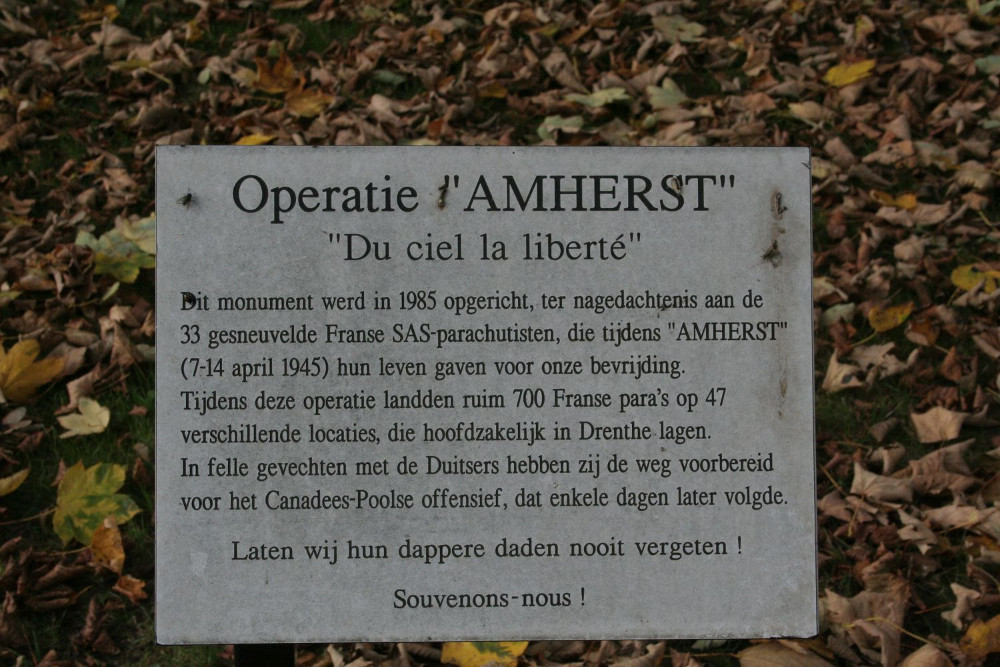
Du ciel la liberté ("Freedom from Heaven") During this operation more than 700 French paratroopers landed on 47 different locations, mainly in Drenthe. Let us never forget their brave deeds! Souvenons-nous (Let's remember!) Source: Arnold Palthe, TracesOfWar
Both battalions jumped off between 22:30 and 00:30 hours in bad conditions. That is to say, visibility was zero, they had to descent through dense cloud cover from an altitude of 1,970 feet and a strong westerly wind was blowing. The jeeps were not dropped because previous reconnaissance as to good drop zones had not been made and no guarantee could be given that our own men would receive the jeeps instead of the enemy. This particular decision was made by the liaison officer with the S.A.S. brigade, Colonel Guy Prendergast, former commander of the Long Range Desert Group. Calvert’s rage about this had not died down, even on October 15, 1970 (!), as is evident from a letter of the former S.A.S. commander to the French Union of Parachutists.
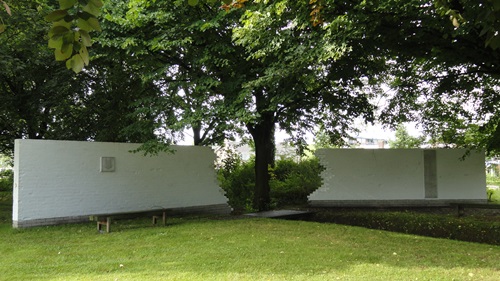
The monument on the Vaart in Assen, erected in 1985 in memory of the 33 French paratroopers who gave their lives for our liberation. Source: Arnold Palthe, TracesOfWar
Almost all 46 sticks dropped, with their gear in containers (the 47th was dropped on the evening of April 8) came down all over the place, except in their designated zones. Four of them even came down amidst retreating German troops. The paras started their task with an almost fatal disadvantage: not knowing where you are and asking strangers for your position not knowing whether they can be trusted. Those who did retrieve their containers with the necessary gear and who were able to regroup, immediately went about their task of creating confusion. In various places, sticks were joined together in order to create more fighting power.
It was not strange that the hunt the paras were to start had been turned around. The paras were now being hunted down themselves, fortunately by an insufficient number of men and little coordination. How long the French could hold out depended on the speed of advance of the 8th Reconnaissance Battalion of the Canadian 2nd Infantry Division along the main route of advance straight across Drenthe via Assen to Groningen. For another part they depended on the assistance of the local population. The letter the paras carried for the benevolent Dutch was aimed at making contact. Only the statement: "..within a few hours you will be free again..", so the letter read turned out to be slightly exaggerated. This letter did not always do the trick but a large part of the farmers proved willing to take the risk to support these French wherever they could. Betrayal was an exception. Unfortunately, many remained on the sidelines, afraid as they obviously were of retaliation.
Fact is that Crerar, after a request by General Calvert, refused to adapt his advance to the increasing needs of both French S.A.S. groups, in particular where ammunition was concerned. Speed, direction and deployment of the army corps remained unchanged. For instance, near Spier where the French had obviously bitten off more than they could chew in trying to contain the local Germans, the losses to the paratroops would have turned out much higher if by coincidence a Canadian reconnaissance unit had not arrived. The Germans judged this arrival incorrectly and their reinforcement, that just emerged from the woods, shied away from a fight and retreated hastily. The French had barely escaped.
Why exactly Crerar refused is unknown. He indeed was a man of "make a plan and stick to it" but a more plausible reason might be he wanted to spare as many Canadian lives as he could after the huge losses in the Rhineland and now in the absolute knowledge of the final victory. And maybe his staff foresaw the problems connected with the total liberation of the Netherlands. As always, the venom is in the tail.
Were all the tasks completed? The oversimplified answer is no but that does no credit to the French. Of course, there was not much left to disorganize and demoralize. The Germans had already reached a state of decay but it is possible that this process was accelerated by the actions of 3 and 4 S.A.S. Consider for instance the attack on Böttger’s command post in Westerbork on April 8, the day the German general Christiansen was placed in command of all units in the north. This attack cannot be considered completely successful but it did cause increasing nervousness and insecurity among the Germans. And the Germans had lost their commanding officer from the onset. Or another example; the ambushes erected by sticks 3, 6,7 and 16 of 2 R.C.P. astride the route Borger – Gasselte – Gieten – Rolde did seriously impede German movements along this route. Elsewhere the Germans could move with difficulty as well as a result of ambushes. The 4th stick of 3 R.C.P. for instance managed to move from hide out to hide out for seven days and engage Germans from various ambushes in the process. Next on April 9, an attack in Gasselte on the Nationalsozialistische Kraftfahrerkorps (NSKK or National socialist corps of drivers) seriously affected the already poor transport capacity. This NSKK provided transport for the Germans, mainly by Dutch drivers. As far as actions against bridges are concerned, those at Smilde and Appelscha can definitely considered completely successful.
The Veenhoopsbrug across the Smildervaart seemed of great importance to the north - south route through Drenthe; it seemed important but the Canadian 2nd Infantry Division did not use the Smildervaart as the main route of advance. This ran via Elp to Rolde and Zuidlaren. The stick that had left a day later had captured this bridge three times in succession and held it until April 12 when the French at the bridge could be relieved by the first Canadian armored vehicles. The same applied to the group that managed to capture the Stokersverlaatbrug in Appelscha as early as April 8th, making passage for the Germans impossible from that moment on and meanwhile taking dozens of prisoners. Prisoners were a serious handicap for the paras: guarding them depleted their fighting power and caring for them thwarted their desired mobility. The orders concerning air fields turned out to be a flop. Not a single group came down close enough to its objective and when finally the air base at Havelte was reached and the Germans surrendered without a fight, the air field proved unsuitable for transport. The R.A.F. had previously bombed the field.
All told, it remains questionable if Operation Amherst had been absolutely necessary to speed up the advance of the Canadians. Earlier on, reference was made to the remark of the commander of the Garries concerning the speed of advance. His remark means a lot.
Definitielijst
- brigade
- Consisted mostly of two or more regiments. Could operate independently or as part of a division. Sometimes they were part of a corps instead of a division. In theory a brigade consisted of 5,000 to 7,000 men.
- Fallschirmjäger
- German paratroopers. Part of the Luftwaffe.
- Infantry
- Foot soldiers of a given army.
- resistance
- Resistance against the enemy. Often also with armed resources.
- Rhineland
- German-speaking demilitarized area on the right bank of the Rhine which was occupied by Adolf Hitler in 1936 after World War 1.
- strategy
- Art of warfare, the way in which war should be conducted in general.
The last round
When you push the enemy forward in a restricted space and simultaneously cut off his escape route, there comes a time when you encounter that same enemy crammed into a smaller space and with a fair chance that his fighting power has increased. This happened to the Army Corps of Lieutenant-general Simonds during the last phase of the liberation of northern and eastern Holland. For the Canadians, the venom was in the tail literally, in this case in the province of Groningen where the Canadian 2nd Infantry Division was to finish the job.
In Friesland there was no question of putting up a defense, at the most how to save one’s skin. Just a single battalion was needed to cross Friesland at break neck speed from Noordwolde up the Frisian Waddencoast north of Dokkum. The brigades of the Canadian 3rd Infantry Division only had to do some mopping up[49]. Only in the sector between Makkum and Pingjum up to the Afsluitdijk, the Canadians had their work cut out for them.
The defense of Groningen began in fact at Festungsstadt Assen, at least, that was the ideal picture. A line along the IJssel extending northwards and named Friesland Riegel with the Asser Stellungen as strategic porch of the northerly defense. However, as is the case so often, the enemy did not follow the route the designer of the line had had in mind. Such was the case on April 18 as well in Assen where the Canadians "refused" to attack the capital of Drenthe from the west but did so from the north and east instead. The Germans sped head over heels in the direction of the city of Groningen. The 6th Brigade had already passed Assen and the 4th Brigade overtook them in order to launch their attack on Groningen from the south. In the evening of April 13, forward units of the 4th Infantry Brigade reached the southwestern suburbs of the city.
In the last chapters, the description of the operation of liberation will be concluded in this sequence[50]: Friesland first, then Gronigen and all this because of the timetable. April 13 will be chosen as some sort of starting date of the last round. That day, the Queen’s Commissioner in Drenthe, Mr. R.H. de Vos van Steenwijk sent a telegram to Queen Wlhelmina in London, informing her that the better part of the province of Drenthe had been liberated. The Canadians bypassed Meppel[51] and advanced northwards via Dieverbrug and Vledder into Friesland, liberating Noordwolde on April 12. Further up the Smildervaart to the north, Oosterwolde and Appelscha were liberated on April 13. Westerbork,[52] Grolloo and Borger saw the last German leave on April 12, as well as Hooghalen which unfortunately suffered severe damage. The old Middendorp burned down completely. Gasselte and Gieten had to wait a day longer. At the same day in the province of Groningen, the Polish Armored Brigade with their "hired help" the Belgians, had already arrived in Onstwedde. Stadskanaal in the south was bypassed as early as April 11 and the same occurred on April 13 near Veendam. Again a whimsical front line but more or less drawn clearly. The Queen’s Commissioner in Drenthe was fully justified to send his telegram.
Definitielijst
- Brigade
- Consisted mostly of two or more regiments. Could operate independently or as part of a division. Sometimes they were part of a corps instead of a division. In theory a brigade consisted of 5,000 to 7,000 men.
- Infantry
- Foot soldiers of a given army.
Liberation of Friesland
Civilian traffic on the route Harlingen – Leeuwarden – Groningen was suspended as early as April 5. Military columns were not to be impeded any longer in their drive towards the Kop (head) of the Afsluitdijk. Subsequently the Germans abandoned the air field in Leeuwarden as a military base. And the "Arbeitsreferent" in Leeuwarden proclaimed that "Ausweise" (ID cards) were no longer necessary because: "Der Krieg ist ja am Ende.." (The war is over anyway) in this province rich in water.
On April 8 at 10:30 hours the important message for the BS came in: "De fles is leeg" (The bottle is empty)[53]. It meant that in 36 hours, sabotaging railways, waterways, roads and telephone communication was to begin. In other words, objects important to the German withdrawal were to be sabotaged. The actions started on April 10 at midnight on a large scale. Locks that suddenly did not function any more, buoys that disappeared from the Waddenzee, bridge operators nowhere to be found while bridges were out of service and blocs of trotyl being replaced by wooden blocs. Members of the SD who had become extremely nervous took revenge by executing 14 of their "Todeskandidaten" (death row candidates) near Dronrijp; Gerard de Jong from Huizum survived the ordeal by pretending to be dead.
It was important for the advancing Canadians that all crossings on their route remain intact and clear of mines. It would delay the advance massively if existing bridges were destroyed. For instance: in order to reach Holwerd from Noordwolde via Drachten, 10 large waterways had to be crossed. It was successful. Nowhere in the Netherlands have members of the BS worked so effectively as in Friesland. Many Frisian villages were already in control of the BS prior to the arrival of the Canadians. In particular the telephone network was kept in operation by the BS in a most efficient manner. The battalion of the Royal Canadian Dragoons was able to complete its victory drive across Friesland almost unimpeded and at maximum speed. The battalion, deployed in Noordwolde on April 12, reached Quatre Bras on April 14, liberating Dokkum immediately after and reached the dyke on the Frisian Wadden and the Lauwerszee from Holwerd and Oostmahorn on April 15.
Things did not always go so smoothly. During the advance of the 9th Infantry Brigade with Leeuwarden as their main objective, one of their units was faced with two blown bridges, the first one across the Oude Schouw, the second across the Syl. That was around 11:00 and 11:30 hours, some two hours after "..we saw the last Jerries walk past.. ", as the father of Mrs. Klaasje de Jonge-de Vries noted in his diary. Both bridges had been blown the previous day. Seven hours later, the engineers had finished constructing the emergency bridge, strongly supported by the local population. Next the endless entry began and enthusiasm was such that a certain Tjerk Fokma provided fresh straw for the exhausted soldiers "..because he did not want them to sleep on Jerry straw.." (quote from the same diary). Little use will have been made of it as the pursuit continued.
The 9th Brigade with its Highland battalions and up ahead the independent reconnaissance battalion of the brigade (the 7th) was impeded by still more blown bridges. Just before Heerenveen, the bridge southwest of Oudeschoot had been blown but the BS had occupied the bridge south of Mildam enabling the scouts to liberate Heerenveen on April 14 via a short detour. The bridge had been used before on April 12 by the Royal Dragoons in their relentless advance north. That day the scouts had already passed Steenwijk and Wolvega. On it went towards Leeuwarden, entering the city after many delays on April 15. Shortly before, a jeep with four men of the Dragoons had entered the city which had been abandoned by the Germans in the meantime. A Leeuwarder citizen reported they were journalists whom they could welcome as their first liberators. The great exodus of Germans straight through Leeuwarden from east to west took place on April 13 and 14 until late in the evening. "..It was a scene never to be forgotten…..It seemed there was no end to the ragged procession .. Here and there a Jerry girl was seen.."[54] such as Friese Lenie or Engel, well known lovers of the SD. Going east was impossible as the Allies had already occupied a large part of the Heimat. Cynically, the Festung Holland was their only, albeit idle hope. They had to reach the Afsluitdijk before they would be cut off here as well by troops of the Canadian 8th Infantry Brigade.
One of the battalions raced westwards from Leeuwarden in order to liberate Harlingen but on that Sunday, April 15, they did not get beyond Franeker. The Canadian point turned about near Franeker, thereby giving some 500 Germans left behind in Harlingen the opportunity to carry out wide spread demolitions on Sunday April 15 and Monday April 16. Bridges were blown and some 15 vessels were sunk. On Monday morning, Canadian forward units reached Midlum, just outside Harlingen. Early in the morning, the city was heavily shelled by artillery from Herbaijum, directed by an aerial observer. The Canadian commander had turned to a tried and tested method: soften up with grenades first, then enter. A firefighter from Harlingen later declared here and there sheds were burning like torches ".. it was a sea of flames.." Later that night skirmishers moved into town and managed to capture the city center around midnight. The Canadians encountered a remarkable number of German soldiers, dead drunk. Was the alcohol to serve as a means to forget the misery or did this situation grant the occupiers the "holy fire" to continue an utterly senseless defense? Even during the next morning, there were still groups of Germans offering resistance to ".. those Chinese ", a woman from Harlingen remembered. They also were so strangely dressed "..with leather coats and quite different helmets and .. so many cigarettes." In the meantime, Van der Meer had started selling flag and buttons. What a party it was, as Harm Gerritsen tells about his mother and what he experienced himself as a child.
The 8th Brigade was ordered to clear the western part of Friesland. Their main route of advance ran from Wolvega – Joure- Sneek – Bolsward to the Kop of the Afsluitdijk. From this route they spread out to their left and right. In Wolvega they struck in the direction of Kuinre but the inhabitants had to wait three days before being liberated. People could hardly stomach Wolvega was already celebrating and "in Slijkenburg we could see the flag on the water tower" as Trijntje van der Lende – who grew up in Slijkenburg – said in an interview. More quotes from that interview: "the bridges to the Kuinderpolder and at Schoterzijl had beam blown on Saturday April 14." Finally the Canadians of the Chaudière battalion arrived "who were entering Slijkenburg from Schoterzijl along the foot of the dyke… Harmen Visser, a policeman from Vollenhove who was driving in front of the Canadians, was shot."[55]
On April 15, Joure was bypassed by units of the 8th as well as the 9th Brigade and almost all of Sneek was liberated in the afternoon of the 15th. Here the B.S. also dominated the entrances to the town and all the Chaudières had to do, so to speak, was reading their maps and clearing the way for the next battalion (the New Brunswick) that was to advance to Koudum via Bolsward. That was in the early morning of the 16th but Germans were nowhere to be found in the town though. Yet, it would take until the 17th before Koudum was reached where the day before, B.S. fighters had already arrested members of the N.S.B. who had been taken to prison under loud cheering. Nobody bothered any more about curfew and the next morning, a group of Canadians drove into Koudum. ".. they parked their vehicles in a meadow near the center of the village and conducted themselves in a rather relaxed manner. They handed out chocolate and cigarettes and chatted with the villagers. The party was short lived. After another short drive through the village, they left again..", as a "food tourist" remembered who survived in Koudum with his family. After the Canadians had left, daily life returned almost unchanged in the village of Koudum.
The Chaudières made an attempt to reach Lemmer from Sneek but had to return in order to reach their objective via Joure and Sint Nicolaasga. At Woudsend, the B.S. could not prevent the bridge from being blown up. The Scharsterbrug between Joure and Sint Nicolaasga across the Scharsterrijn was blown up by the Germans on Sunday morning on April 15 at around 10:30. The occupier subsequently barricaded himself in the dairy factory. The Canadians constructed a Bailey bridge across the canal, enabling the battalion, supported by artillery, to successfully drive off the enemy in the direction of Lemmer late in the evening of the 16th. At the bridge fierce fighting still went on, claiming the lives of 11 Germans, a Canadian and two civilians. During the engagement between Canadians and Germans at Scharsterbrug, a Czech lost his life as well. This man had deserted from the German army a few months earlier and had joined the Dutch resistance. When the Canadians arrived, he joined the liberators. During the entry in Scharsterbrug, he was sitting on a tank and he was killed by a German sniper, according to eyewitnesses. Lemmer was captured on April 17 as the Germans had already left across the Ijsselmeer. For a brief moment, an emergency seemed to develop because of possible breaching of dykes in the Noordoostpolder. However, three Poles in German service, hid the detonators needed to trigger the explosive charges already in place and fired at "friendly" soldiers. On April 17, the Noordoostpolder had been liberated as well, thanks to three Poles and a Canadian battalion.
The last obstacle facing the Canadian 3rd Infantry Division was the triangle Pingjum – Kop Afsluitdijk – Makkum. First the usual scene: "Sunday, April 15, 1945. Suddenly, the inhabitants of the tiny village of Pingjum are startled by the rattling of wagons. Soon they see who the drivers of these wagons are, the suppressors, the Germans."[56] Withdrawing Germans but a large group remains in Pingjum. Snipers and machinegun posts to delay the advancing Canadians. A urgent request to surrender was summarily rejected and the battalion commander was left with only one option: shelling by artillery and mortars. The barrage started on Monday evening, April 16 at 19:30 hours and would last until late in the afternoon of the 17th. The village suffered severe damage and around 15:30, white flags were flown. Two Canadian envoys approaching the Germans were shot and fell to the ground injured. For the battalion commander, this was the signal to launch the final attack at 17:00 hours. Again with the necessary fire support, the first Canadian carriers entered the town, took the occupiers prisoner and separated the SS men from the rest. Miraculously, these engagements claimed the lives of no more than six civilians. Quote: "After the inferno, chaos reigns in the village: dead horses, cows, goats, dead soldiers, belts with the arrogant text ‘Gott mit uns’ (God be with us) on the buckle,.. a village in flames, smelling of gun powder where mooing unmilked cows wander around aimlessly and loose horses gallop through the streets, the ears flat against their heads.."[57].
Later on, the battalion of the Queen’s Own Rifles was supported by the New Brunswick battalion in the fighting on the Afsluitdijk. It was the artillery that proved the critical factor of success for the Canadians. As late as April 18, the Germans abandoned the "Kop" and on the same day, Makkum could be occupied by the Brunswicks, supported by the Typhoons of the R.A.F. The 3rd Infantry Davison of Major-general Keefler had endured 26 days of fighting, advancing over 124 miles, constructing 36 bridges and taking 4,600 German prisoners. They were not to be granted any rest yet.
Definitielijst
- Brigade
- Consisted mostly of two or more regiments. Could operate independently or as part of a division. Sometimes they were part of a corps instead of a division. In theory a brigade consisted of 5,000 to 7,000 men.
- Infantry
- Foot soldiers of a given army.
- resistance
- Resistance against the enemy. Often also with armed resources.
- shelling
- Indication for shooting targets with grenades. Both from artillery and armoured artillery.
- sniper
- Military sniper who can eliminate individual targets at long distances (up to about 800 meters).
Liberation of Groningen
The cities of Groningen, Delfzijl and the coast of the Dollard beyond Winschoten were the main targets in this last phase. Units of the Canadian 2nd and 3rd Infantry Brigade were deployed in this province. "Highlights" of the liberation were the battles for the city of Groningen and the Delfzijl pocket.
The city of Groningen
As the 2nd Infantry Division continued its advance north, it was protected on its left flank by the fast moving Royal Canadian Dragoons. The division faced the problem of the conduct of the enemy being totally unpredictable. An orderly withdrawal was out of the question as coherence had been lost entirely. The climax for the troops was no doubt the city itself. The enemy had become a hotchpotch of parachutists, air force personnel, SS men, soldiers of the Kriegsmarine, Hitler Youth and who ever else could carry a weapon.Matthews deployed his entire division against this hotchpotch. First the 4th Brigade in the southwest where they met fierce resistance. In the night of April 13 to 14, the fighting raged on relentlessly, more than once in hand to hand combat. House after house had to be taken, snipers could hardly be located, machinegun nests were sited in cellars trying to create mayhem from those positions. Dutch SS men had sometimes put on civilian clothes in order to "carry out their duties", often from a story of the closely packed houses and more than once houses were exchanged between Canadians and Germans. It was characteristic of the chaos in this early phase.
Saturday April 14 became a critical day and the brigade could take possession of the southern sector of the city. The Essex Scottish Battalion had build a bridge across the canal in order to enable the 6th Infantry Brigade to pass through the 4th and capture the city center. Meanwhile, a company of the Essex had already reached the perimeter of the inner city. Three infantry battalions of the 6th Brigade, reinforced by units of the Fort Garry Horse, a field artillery unit and heavy machinegun platoons of the Toronto Scottish were to carry out this task. As it was too dangerous for the tanks to maneuver at night because of the threat of the Panzerfaust, it was decided to wait until the early morning of April 16. Main target was the Grand Market Square with the town hall. Fierce fighting ensued and large fires erupted everywhere. Strategic intersections were immediately occupied by the Garries. Much time was wasted tracking down Germans hiding in the piles of debris, in gardens, in fire corridors and of course also in the houses themselves. The inhabitants of the city were still wary and were able to celebrate only when it was quiet for a few moments. The notorious Scholtenhuis in the center of the city, which was still occupied by members of the SD who refused to give up the struggle, was completely demolished by fire from tanks.
Meanwhile the Calgary Highlanders had moved up from the south, the Maison Neuves from the southwest with the Black Watch battalions of the 5th Infantry Brigade. In this way, the German defense could quickly be surrounded. The Maison Neuves, again reinforced by tanks of the Fort Garry Horse, began their drive on April 14 at 14:00 hours. At 18:15, the battalion had reached its objectives on the Hoendiep and consolidation could begin. Subsequently the Highlanders and the Black Watch passed through the bridgehead of Maison Neuve. The initial bitter struggle was decided in favor of the Canadians after the deployment of flamethrowers.
On Sunday April 15, at 18:00 hours, the Maison Neuves stood ready once more to continue the battle to the north of the inner city, along with the Black Watch. In fact, the Germans were completely surrounded and the engagements during the evening mainly concerned small groups fighting each other. Late in the evening, this part of the city was also liberated. The only obstacle remaining was the complex of buildings of the Provinciaal Electriciteitsbedrijf (Provincial power works). A shortage of ammunition forced the Germans to surrender rather quickly. That was on Monday, April 16. The 4th Brigade was pulled out while the 5th and 6th were still busy mopping up the last spots of resistance while the German commander had capitulated. The battalion commander of the Mont Royal Fusiliers had extorted this surrender.
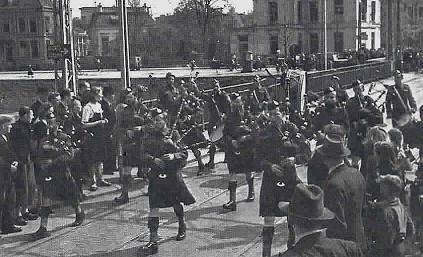
April 17th: Scottish bag pipers of the Essex Scottish Regiment on the Heerebrug in Groningen. Source: Bevrijdingskinderen
In the northeastern and northern part of the city, the Black Watch, the Maison Neuves and the Camerons of Canada were advancing in the direction of the Van Starkenborghkanaal, the Camerons crossing this canal aided by a few civilians. This battle lasted four days and the 2nd Davison covered a distance of some 124 miles and took over 5,000 prisoners in 16 subsequent days.
The sector of Delfzijl
Beyond the city of Groningen in the direction of the Dollard, heavy fighting was yet to take place. The 7th Infantry Brigade of the Canadian 3rd Infantry Division and later on two brigades of the Canadian 5th Armored Division were charged with mopping up the last remaining hostile defense. Delfzijl was surrounded by a strong defensive belt that could count on massive support by heavy artillery.Without much resistance and enthusiastically supported by resistance fighters, the Regina Rifles Battalion advanced in hops and jumps and the northeastern part of the province was cleared of the enemy on April 20 and 21 up to the line Middelstum – Garsthuizen – Roodeschool – Usquert. It was only when the battalion reached Spijk, southeast of Roodeschool that it came under heavy artillery fire. A little later, the battalion would be relieved by the Perth Battalion of the 11th Infantry Brigade, part of the Canadian 5th Armored Division.
Meanwhile, the Royal Winnipeg Rifles Battalion (of the 3rd Division) had reached Loppersum. The main danger was caused by the long range German artillery and the notorious Nebelwerfer with their unpleasant and demoralizing sound. The 7th Reconnaissance Battalion had done wide spread reconnaissance in the meantime and had warned for various German combat teams with a fanatical desire to continue the fight. Many bridges had been destroyed and the terrain was poorly passable. The Winnipegs, supported by tanks, continued their advance in the direction of Wirdum in order to attack Appingedam from the northwest. The German artillery barrage was so heavy and so badly directed, it was decided to evacuate the citizens of Appingedam. The town was shelled by 11 inch naval guns.
In the evening of April 23, the Winnipegs were relieved by the 9th Tank Battalion (the British Columbia Dragoons of the 5th Armored Division, itself an element of the Canadian 5th Armored Division). During the night, this battalion and the Perth battalion moved to Krewerd, northwest of Delfzijl, in order to lay the foundations of the attack on the Delfzijn pocket from there. Marsum, a few miles further towards Delfzijl was liberated as late as April 29. Around the pocket of Delfzijl, no one was safe from German fire. The local population in particular suffered heavily. The German artillery positions could only be overrun by precision attacks.
The first success was scored by patrols of the Perth battalion. During the night of April 28 to 29, one of the most notorious positions was stalked and captured after ferocious combat. The Cape Breton Highlanders, part of the 11th Brigade as well, took over from the Perth. The attack was launched on April 30 at 10:00 hours. Delfzijl was eventually captured on May 1 in hand to hand combat with the necessary support of tanks. The day after, the Irish Regiment of Canada would force the last resistance in the Delfzijl pocket to surrender near Weiwerd and Farmsum. These last days resulted in over 4,000 prisoners of war; in contrast own losses were limited: less than 150 dead and injured.
Definitielijst
- Brigade
- Consisted mostly of two or more regiments. Could operate independently or as part of a division. Sometimes they were part of a corps instead of a division. In theory a brigade consisted of 5,000 to 7,000 men.
- Infantry
- Foot soldiers of a given army.
- Kriegsmarine
- Germa navy. Part of the Wehrmacht next to Heer and Luftwaffe.
- Panzerfaust
- German anti-tank gun used by the infantry. Consists of a long tube with the grenade mounted at the front side. It was a disposable weapon. After being used it cannot be reloaded. Major disadvantage is the long flame back blast from the tube.
- Regiment
- Part of a division. A division divided into a number of regiments. In the army traditionally the name of the major organised unit of one type of weapon.
- resistance
- Resistance against the enemy. Often also with armed resources.
Epilogue
For eastern and northeastern Holland, the liberation as a whole had come to an end. The people were marked by war. The cheering died down, restoration faltered. Shortages in housing, unemployment, debris, hundreds of thousands of land mines not yet found, the situation of food stuffs was bad all over, power supply not yet fully operational and a bureaucracy seriously delaying the trials of "wrong" fellow countrymen. Those were just a few aspects, apart from the permanent scars that disillusioned many people and seriously affected faith in political leadership.
A 17 year old food tourist, who had been taken in caringly by a family in Friesland between March 9th and June 30th, described her freedom as follows: "..we waited and we waited. When they came, the Canadians, they sped past in a flash. And we were cheering. We were free.. I returned home in Rotterdam on June 30th .. we had to walk the line again .. work again. It felt a little like the end of my freedom.."
And this also was freedom, albeit somewhat later. The moment at which a Jewish boy in hiding sees his mother again as she is taken to the Van der Hoop family in Holwerd by a soldier of the BS, sitting behind him on his motorcycle. From the diary of Uri Speelman, quote: "Gradually, the entire family stood around me. I did not understand. Suddenly that same soldier rode up on his bike with a dark haired, skinny woman sitting behind him.(In Friesland, everybody was blond haired). My foster mother asked ‘Who is that then?’ I answered in Frisian: ‘I don’t know.’ Then she said: ‘Look closely’ and then I shouted in Frisian: ‘That is my mother.’ She stayed in Holwerd for 14 days and then we rode back to Amsterdam on a milk truck. I am very grateful to the Van der Hoop family in Friesland. Stalwart Frisians."
Notes
- C.P. Stacey, Official History of the Canadian Army in the Second World War, Volume III, The Victory Campaign, The operations in North-West Europe 1944-1945, Ottawa, 1966, p. 548. In this article, I will go back a lot to this study by Colonel Stacey.
- The first issue of the ‘Groninger Oranjebode’, the information bulletin of the combined illegal Groninger Press on April 17th, 1945.
- The notion of the great pursuit had already been overtaken in September 1944. Owing to the necessary redeployment of the scattered units and reconsideration of the logistic activities, some sort of idleness occurred. In hindsight it is clear that the strategy of extreme concentration of efforts and the joining of forces had been a risky enterprise from a logistic point of view. It required a guaranteed support of 15,000 tons of daily supplies while the capacity in the most favorable conditions was no more than 14,000 tons. Montgomery apparently had also taken into account the poor social economic state that prevailed in the U.K. People were "hanging by their fingernails.
- Shortly after, General Student was replaced by General Johannes Blaskowitz. At the time, Heeresgruppe H was made up of 25. Armee in the Netherlands and the 25. Fallschirmjäger with its front between the rivers Meuse and Rhine.
- By the way a magnificent example in the history of warfare of an armored division that successfully manages a circular defense entirely on its own against an overwhelming majority
- Only on 17 January a report from the OBK, then on 29 January a statement from Colonel G. Meyer-Detring of the Army Staff: P.E. Schramm(hrsg), Kriegstagebuch des Ober-Kommandos der Wehrmacht, 1944-1945, Teilband II, Munich, 1982, p. 1019 resp. 1052. By the way, I leave the operation 'Nordwind' unnamed. Its purpose was to cut off the Americans in the Alsace sector. The operation also failed
- Schramm, op. cit. , pp. 1042/1043, Colonel G. Poleck, G4 of the Army Staff on January 26, 1945.
- ibid, p.986, Colonel Poleck on January 3, 1945.
- ibid, p.990, Colonel Meyer-Detring on January 4, 1945...
- ibid, p. 1042
- Stacey, p. 463. Better still, those who cannot actively participate in combat owing to illness (the Magen) than those who are so old and at the end of their days, they don’t even hear the explosions of artillery shells on impact any more during a preliminary barrage (the Ohren), according to Generalmajor Heinz Fiebig.
- Schramm, op. cit., p. 1079
- ibid.
- ibid. p. 51
- ibid.
- Morton & Granatstein, op.cit., p.57.
- Schramm, op.cit., p.1118.
- But it had to be nice weather!
- http://www.multipointproductions.com/heroes/loren/hochwald
- G.B. Buchanan, LtCol., The History of the South Saskatchewan Regiment, Ottawa, 1956, Ch. 11.
- Morton & Granatstein, op. cit., p.60.
- ibid. p. 1158
- ibid. p. 1170
- H. Bernard, Totale oorlog en revolutionaire oorlog, Band III, Brussel, 1977, p. 431.
- A female war correspondent, who has experienced many fronts up close. Normandy, the Ardennes Offensive, Nijmegen, the crossing of the Rhine, the Russians in Finland and Dachau as well.
- Schramm, op.cit., p.1197.
- ibid. p.1198
- It was the usual picture of each liberation. Inhabitants hiding in their cellars from the bombings by aircraft, artillery pieces and mortars but also from tanks firing at point blank range. Moreover, many a German, N.S.B.’er (member of the Dutch Nazi party) and Landwacht (German police) joined in this way of hiding and all inhabitants feared the setting up of defensive positions close to homes and farms. Many civilians were injured or killed as it was nearly impossible to accurately destroy such pin point targets.
- A "Tinus Plotseling" (Sudden Tinus) was a small reconnaissance aircraft (usually a Piper Cub) with an observer directing artillery fire from the air. It was a nickname, probably introduced by inhabitants of Twenthe because this Piper Cub announced imminent liberation.
- A. Berkel, Krieg vor der eigenen Haustür, Selbstverlag des Stadtarchivs Wesel, 2004, p. 199.
- ibid. p. 216
- The longest bridges, constructed by the military were near Xanten and Rees, measuring 1,552 and 2,154 yards respectively. Admittedly, at the end of the war, the 21st Army Group would have constructed 2,000 Bailey bridges between the rivers Seine and Weser. See Bernard, op. cit. p. 432.
- For example in Chronologie Fryslân 1940-1945, at http://www.verzetsmuseum.nl/.
- . T. de Goede, "De gem. Bergh in den tweeden wereldoorlog", in: "Er op of er onder", W.P. Nederkoorn and G.J.B. Stork, Doetinchem, 1970 (reprint), pp. 142, 143. A ‘Chaud’ would have said ".. peut-être le plus bombardé dans l’histoire de la guerre .." (probably the most heavily bombed area in the history of warfare) in: Stacey, op.cit., p.542. Stacey argues correctly this statement is exagerrated but it gives some idea of the damage inflicted.
- Between the IJssel and the line Doetinchem – Vorden – Almen on the Twenthe canal; the 1st Division was operating in addition to the 2nd and 3rd Infantry Division. The 1st was ordered to turn into a westerly direction between Zutphen and Deventer. In fact, three divisions were operating simultaneously in a very restricted area.
- A.J. Sloot, Doesburg veertien dagen door de Canadezen belegerd, in: Er op of er onder, W.P. Nederkoom en G.J.B. Stork, Doetinchem, 1970 (repr.), p. 351.
- J.W. Remmelink, 37.000 Granaten teisterden Dinxperlo, in: Er op of er onder, sie note 7, p.156.
- L.E. Brink Traanboer, Wisch in bezettingstijd 1940-1945, Firma gebr. De Boer, Aalten, 1987, p. 160. and p. 170
- In the west near Almen, everything proceeded smoothly. The 4th Infantry Brigade crossed the canal in the night of April 2nd to 3rd, preceeded by the Royal Regiment of Canada so fast, they ran into an enemy who was fast asleep. On April 3, the road was open to the 5th Brigade to pass through the 4th and advance quickly. A second bridgehead was established near Delden by the 4th Armored Division.
- E.M.Wilson, 10th Canadian Armoured Regiment (Fort Garry Horse) War Diary – April 1945, The Fort Garry Horse Museum and Archives, 2005. LC Wilson was the commander of the10CAR FGH
- 341 Battery, 86th Field Regt RA (Herts Yeomanry) WAR DIARY, 3 June 1944 to 9 April 1946, Lt. Beck (compilation), p.70, via:http://web.ukonline.co.uk/benjaminbeck/batterydiary.htm
- Mr. A. Metselaar sent a message to the editor concerning the argument in this article that the enemy threatened Hoogeveen from Ten Arlo. He argues this is impossible as Ten Arlo had been set on fire and abandoned by the Germans a few days before. In his opinion, the biggest threat came from the Georgian soldiers on the island of Texel. If those Georgians had not revolted, the unit would have been sent to Drenthe. From Friesland they could have launched a counterattack along the canals, a fine line of defense.
- L. Huizing, De Bevrijding. De laatste Duitsers, de eerste bevrijders, in: Hoogeveen, 1940-1945, Publication Historische Kring Hoogeveen, 1999, p. 391.
- A letter from Department of War, section Military History, dated 25.7.1947, in: Archives Municipality of Hoogeveen, Secretarie 1914-1975, file no.: 2647, History of the Municipality of Hoogeveen during the war, occupation and liberation (1940-1945).
- ibid.The Mayor investigated the inflicted demographic, social-economic and social-cultural damage at the request of the Military Commissioner for the Province of Drenthe
- I have the book by Roger Flamand (translated by: LC. b.d. J.H. Jansen), Operation Amherst. French para's fought in Drenthe, April 1945, Boom, Amsterdam, 2003 (3rd ed.), used as main source. Due to time pressure I could not use another source of David Portier, Les parachutistes S.A.S. de la France Libre.
- The operation of first Cdn Army,2-11 Apr.45, Directorate of History, National Defence Headquarters, Ottawa, July, 1986, p.38 –56. This report had not yet been fully checked for precision at that time.
- Metselaar, op.cit., p.7.
- Those were the 8th and 9th Infantry Brigade. The 7th Infantry Brigade was granted a rest after the fierce fighting for Deventer and was held in reserve beyond Zwolle and Steenwijk. On April 19th, the brigade would join the battle again in northeast Groningen.
- For this chapter I have mainly used the widely quoted book by M.H.Huizinga, Maple Leaf Up, de Canadese opmars in Noord-Nederland April 1945, J. Niemeijer, Groningen 1980.
- According to Stacey, Meppel was liberated on April 13 by D Squadron of the Manitoba Dragoons but according to their war diary, the Mantobas were already in Germany at that date.
In 2011, the editor of this website received a message from mr. Van Snippenberg. He informed us that Meppel had not been liberated by the Manitoba Dragoons but by the C Squadron of Royal Canadian Dragoons. He took this from the war diary of the regiment. - Camp Westerbork was liberated by coincidence as it was not included in the plans as an objective. On April 12, there were still 909 Jews in the camp who had at an earlier moment, made 909 times seven Dutch guilders for their traitors. For each Jew they betrayed they earned seven guilders.
- Y. Schaaf, Laarzen op de Lange Pijp, Van Wijnen, Franeker, 1994 (3rd ed.), p.341-348.
- From the Harlinger Courant: Harlingen tijdens de Tweede Wereldoorlog, p.3
- An interview with Trijntje van der Lende who grew up in Slijkenburg: http://www.stellingwerven.dds.nl/.
- http://www.dorppingjum.nl/
- ibid. The text shows in a beautiful way the emotions of a human being under such circumstances.
Information
- Translated by:
- Arnold Palthe
- Published on:
- 23-03-2020
- Last edit on:
- 30-09-2024
- Feedback?
- Send it!
Related sights
Sources
-C.P. Stacey, Official History of the Canadian Army in the Second World War, Volume III, The Victory Campaign, The operations in North-West Europe 1944-1945, Ottawa, 1966.
-P.E. Schramm(hrsg), "Kriegstagebuch des Ober-Kommandos der Wehrmacht, 1944-1945, Teilband II," München, 1982.
- Morton & Granatstein.
- The History of the South Saskatchewan Regiment, G.B. Buchanan, LtCol., Ottawa, 1956.
- Totale oorlog en revolutionaire oorlog, H. Bernard Band III. Brussel, 1977.
- Krieg vor der eigenen Haustür, A. Berkel. Selbstverlag des Stadtarchivs Wesel, 2004.
- Chronologie Fryslân 1940-1945, op www.verzetsmuseum.nl.
- Doesburg veertien dagen door de Canadezen belegerd, A.J. Sloot, in: "Er op of er onder", W.P. Nederkoom and G.J.B. Stork, Doetinchem, 1970 (reprint).
- 37.000 Granaten teisterden Dinxperlo, J.W. Remmelink, in "Er op of er onder", W.P. Nederkoom and G.J.B. Stork, Doetinchem, 1970 (reprint).
- Wisch in bezettingstijd 1940-1945, L.E. Brink Traanboer. Firma Gebr. De Boer, Aalten.
- 10th Canadian Armoured Regiment (Fort Garry Horse), E.M.Wilson, War Diary – April 1945, The Fort Garry Horse Museum and Archives, 2005.
- 341 Battery, 86th Field Regt RA (Herts Yeomanry) WAR DIARY, 3 June 1944 to 9 April 1946, Lt. Beck (compilation) via:website.
- L. Huizing, De Bevrijding. De laatste Duitsers, de eerste bevrijders, in: Hoogeveen, 1940-1945, Uitgave Historische Kring Hoogeveen, 1999
- A letter from MvO, section Krijgsgeschiedenis, dd. 25.7.1947, in: Archief Gemeente Hoogeveen, Secretarie 1914-1975, dossiernr.: 2647, Geschiedenis der gemeente Hoogeveen tijdens de oorlog, bezetting en bevrijding (1940-1945).
- Operatie Amherst. Franse para’s vochten in Drenthe, april 1945, (vertaling door: lkol. b.d. J. H. Jansen, Boom, Amsterdam, 2003 (3e dr.)
- The operation of first Cdn Army,2-11 Apr.45, Directorate of History, National Defence Headquarters, Ottawa, July, 1986.
- Maple Leaf Up, de Canadese opmars in Noord-Nederland april 1945, M.H.Huizinga. J. Niemeijer, Groningen 1980.
- Laarzen op de Lange Pijp, Y. Schaaf. Van Wijnen, Franeker, 1994 (3e dr.).
- www.multipointproductions.com/heroes/loren/hochwald.
- www.stellingwerven.dss.nl.
- www.glimmerveen.nl.
